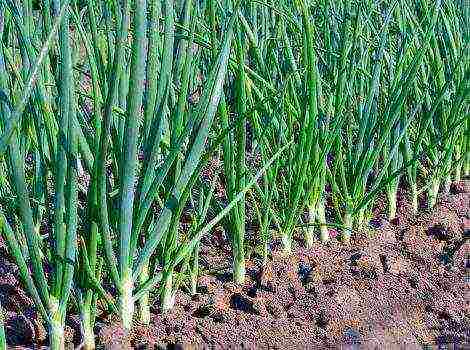Content [show]
An ideal solution for summer residents who dream of decorating a plot with a hedge of unpretentious and ornamental plants is the western thuja. The queen of conifers will give you a lot of positive emotions and will reliably protect you from prying eyes.
Thuja occidentalis is a massive tree with an elongated narrow-pyramidal crown, which becomes ovoid over the years. The bark is reddish or gray-brown. The birthplace of the tree is the eastern regions of North America. Currently, more than 150 varieties of western thuja have been registered. There are dwarf and tall varieties (the height of which reaches 20 m). Recently, even creeping forms have been bred by breeders. Which variety is best suited for a summer cottage?
Benefits of western thuja
Unlike its eastern "sister", western thuja has a number of advantages that allow it to be grown in the middle lane. For example:
- it is an evergreen and ornamental plant that allows you to form a hedge anywhere on the site;
- western thuja adapts more easily to winter cold and frost and does not need winter shelter;
- it is convenient to cut the plant and give it the desired shape;
- a thuja hedge reliably protects the site from smoke, dust and wind;
- western thuja easily resists diseases and pests.
How to choose the right one
In order for the evergreen "beauty" to please you for many years, you should assess the condition of the site. This primarily applies to the type of soil and shade. Then you need to take into account climatic features (average annual temperatures, precipitation, minimum winter temperatures, etc.). Based on this, one should choose one or another variety of thuja and look for a suitable variety.
When buying, inspect the plant itself and the condition of the roots
General recommendations for choosing a thuja look like this:
- needles on a healthy thuja seedling should not crumble or break;
- you should not buy seedlings with bare roots - they could be damaged during transportation;
- the roots should not be chopped off, otherwise the plant will not take root;
- there should be no signs of diseases and yellowing on the crown and trunk of the thuja;
- the earthen lump should not be overdried - irreversible changes could have occurred in the root system, and it will no longer be possible to "water" the plant.
Ideally, seedlings with a closed root system (in small containers or wrapped in burlap) should be chosen. Experienced gardeners are advised to choose young plants - they are cheaper, take root more easily and grow more actively. Do not be confused by a light green bloom and residual weeds in the pot - these are normal signs of a newly planted thuja.
How to plant thuja correctly
Thuja can be planted in open ground at any time, from early spring to late autumn. Plants with an earthy clod it is more expedient to plant in mid spring (from the end of April to the first half of May) or early autumn (mid-August - mid-September). During this time, they manage to strengthen the root system and tolerate winter cold more easily.
It's good if a fence protects the tuyu from the prevailing winds
For landing thuja suitable places in partial shade and isolated from direct sunlight. The abundance of light impairs the decorative qualities of the thuja and reduces the resistance of the tree to cold. When planting, avoid drafts, waterlogged areas with a close location of groundwater (at a level of 1-1.2 m) and places where rainwater and melted snow accumulate.
Thuja takes root most quickly on light and moist soil, but on heavy clay and dry soil, the needles begin to dry out and turn yellow.
It does not follow to plant thuja near massive fruit and other trees, because the root system of “old-timers” begins to compete with its roots, and they do not receive the required amount of nutrients from the soil.
When creating a single row hedge distance between seedlings it can be about 1 m, with a two-row planting - 2 m, and for large varieties of thuja, a distance of 5 m should be left. Planting depth seedlings - 70-80 cm.
Landing pit should be of such a size that the root collar remains outside and is lightly covered with earth, and not buried. Before planting in the hole, you can add the following mixture:
- 2 parts of leaf or 2 parts of sod land;
- 1 part sand;
- 1 part peat;
- 50-100 g of nitroammophoska.
A composition of:
- 2 pieces of leafy land;
- 2 parts of sand;
- 1 part peat;
- 3 parts of humus.
Sometimes this mixture is also used:
- 3 parts of sod land;
- 2 parts of humus;
- 1 part sand.
Fill the hole with the prepared mixture and plant the seedling. After that, abundantly pour plant even if it rains. This must be done so that the soil is compacted and the water fills all the voids.
In case of drought, the thuja should be watered every 3-4 days with 20 liters of water
Trunk circles it is advisable to cover with peat, loose compost, wood chips, crushed bark or colored pebbles. Mulching makes it easier for the tree to take root in a new place, prevents the growth of weeds, protects the root system from drying out, as well as from overheating in summer and hypothermia in winter.
In the fall, grass mulch should be replaced with spruce branches so that mice do not start in it.
How to care for western thuja
It is especially important to care for the thuja hedges in the first years after planting. Trees need minimal maintenance - weeding, watering and loosening... Watering in the first two months requires abundant (at least 10 liters of water for each tree weekly). Thuja should be watered in the evening or in the morning so that the roots have time to get saturated with moisture before daylight. For 2-3 years after planting, you don't have to worry about fertilizers - the tree received them with a margin at the time of planting. Starting from the third year, thuja must be fed with special fertilizers recommended specifically for these plants. In early spring conifers are fed with the drug Kumir-universal at the rate of 120 g per 1 sq. m. For embedding in soil, use urea, calcium and ammonium nitrate at the rate of 20-30 g per 1 square meter of the trunk circle.
Thuja look very impressive in a Japanese garden
In the early years of thuja growth, protect trees from the bright sun, covering them with an awning or sprinkling. Do not forget that a young and immature plant may not cope with severe frosts, therefore, during the first winter after transplanting, it should be covered with an awning or sprinkling.
An important component of the care and cultivation of thuja is pruning... It can be formative and sanitary. For sanitary pruning in April, dry, yellow and diseased branches are removed from the plant, and the heavily thickened crown is thinned out to ensure air circulation and prevent the development of diseases.
For decorative trim there are a few prerequisites to keep in mind:
- trimming the upper part of the thuja corrects the height of its growth;
- to form spherical bushes, first of all, you need to remove the branches that are knocked out of the general shape of the crown;
- to maintain a given shape, constantly remove the one-year increment.
Western thuja varieties for the middle lane
The following varieties are best suited for planting in the middle lane and northern regions: Brabant, Wagneri, Globoza, Danica, Columna, Sankist, Smaragd, Stolvik, Holmstrup, Fastigiata.
Having planted the western thuja on your site, you will become the owner of the "royal tree" that adorns the site and at the same time requires minimal maintenance. Experiment and share your results with us.
Thuja Thya is a coniferous plant from the cypress family. There are five species of trees or shrubs in the genus, but in Russia in ornamental gardening, the most popular type of Thuja western Thuja occidentalis, she comes from North America, came to Europe in 1536.
Description of western thuja
This is a slow-growing tree, reaching a height of 15-20 m, although taller specimens are found in nature, but this is already a rarity.The crown of the western thuja is pyramidal or ovoid, in the original species it is rather spreading. The root system is compact.

The bark at a young age is brick-brown, smooth, eventually turns gray-brown, in a tree with more than a decade of history, the bark on the trunk is in deep longitudinal cracks, fibrous.
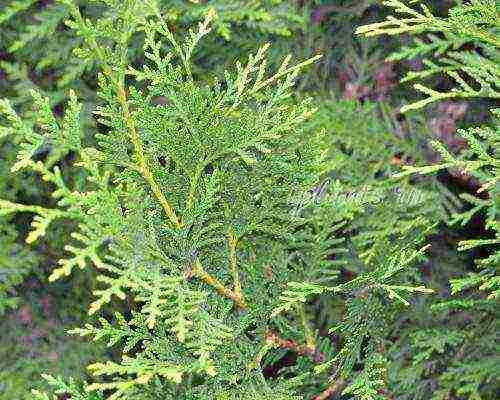
Thuja needles are scaly, green and very small 2-4 mm long, covering the branches like scales. The life of the foliage is a maximum of 2-3 years, then it falls off, but not one by one, but in small branches, the crown is renewed gradually and imperceptibly. By winter, the needles are discolored to yellowish green or brown. The concept of "evergreen" for thuja is relative, if a spruce or pine does not change the shade of the needles at all in winter, then most varieties of western thuja paint the garden in yellow brownish or light green colors.
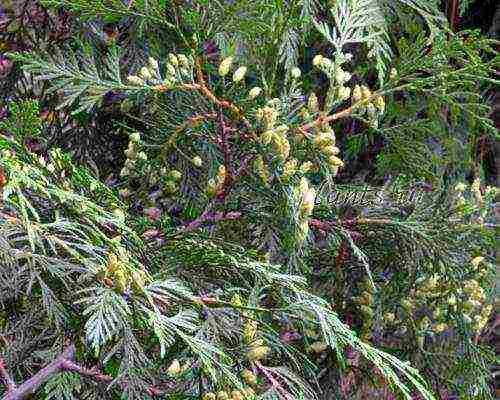
Flowers are not decorative - monoecious, apical, solitary. Cones are also small, about 1 cm long, ovoid. Each cone contains two yellow winged seeds.
The wood on the cut is reddish, often interspersed with brown, yellow and red veins. The wood is soft and durable, does not contain resin, does not rot and could be an excellent furniture material, but has not found widespread use - this is hampered by too slow mass growth and fibrous bark.
Peculiarities
Thuja is very popular not only in private gardens, but is also widely used for urban landscaping, since the plant is extremely unpretentious to the ecology of the city: it tolerates gas pollution, dustiness and smoke well. It easily takes root after transplanting, lends itself well to pruning and shearing, some varieties do not require any shape correction at all - they grow by themselves in a pyramid, ball or cone. In addition, western thuja and its varieties are winter-hardy (frost-hardiness zones from 2b to 8b, this is about minus 36 ° C in winter without shelter).
Varieties and varieties of western thuja
The western thuja has several decorative forms:
- weeping
- columnar (pyramidal)
- hemisphere
- spherical
By color of foliage (needles) varieties:
- variegated (several color variations)
- with green leaves
Tall:
- full-grown from 5 m and more
- semi-dwarf from 3 to 5 m
- dwarf - mature trees up to 3 m
- miniature - less than 3 m in height
According to frost resistance: there are varieties that freely tolerate winters in central Russia, there are varieties that require mandatory shelter.
Here are some frost-resistant ones:
- Danica (Danica) is a miniature variety up to 60 cm or slightly higher in height, spherical in shape, winter hardiness - climatic zone 3.
- Globoza (Globosa) is a spherical miniature thuja, adult no more than 2 m, growing very slowly, winter hardiness - 3 climatic zone.
- Golden Globe - semi-dwarf spherical, slow growth rate, very frost-resistant - climatic zone 2b.
- Wagneri (Wagneri) - narrow-conical shape, semi-dwarf (up to 3.5 m), fast-growing, winter hardiness - 4 climatic zone.
- Woodwardii ('Woodwardii) - semi-dwarf wide-rounded form, grows slowly, winter hardiness - 4 climatic zone.
- Hoseri - spherical, fast-growing, up to 2 meters high, winter hardiness - 3 climatic zone.
- Brabant - conical, fast-growing, the variety is similar to Smaragd, but the growth rate is 2-3 times higher, winter hardiness - climatic zone 3.
- Sunkist - conical thuja of semi-dwarf growth, growing slowly, very frost-resistant - climatic zone 2b.
- Tiny Tim is a miniature variety of thuja, no more than 1 m high, spherical, growing slowly, winter hardiness - 3 climatic zone.
- Holmstrup (Holmstrup) - conical semi-dwarf variety, grows slowly, winter hardiness - 3 climatic zone.
- Smaragd is a slow-growing columnar variety, 3-5 m high - average frost resistance - if all of the above varieties can be grown in Siberia and the Urals, then Smaragd freezes at temperatures below minus 25-26.
When choosing a variety, consider not only its size, shape and frost resistance, but also its general unpretentiousness. Some do not tolerate shading, even light partial shade, others do not tolerate long thaws in winter (with sudden temperature changes), as this provokes early sap flow.Some varieties practically do not need pruning, others need to be systematically pruned. There are varieties that are extremely sensitive to compaction of the soil surface, do not grow on clean loam, annual loosening and mulching are required.
Thuja western - place in the garden
Western thuja varieties are quite diverse, not only in appearance, but also in needs. Among them there are varieties that are tolerant of the amount of sun, but most prefer to grow in full sun, if possible.
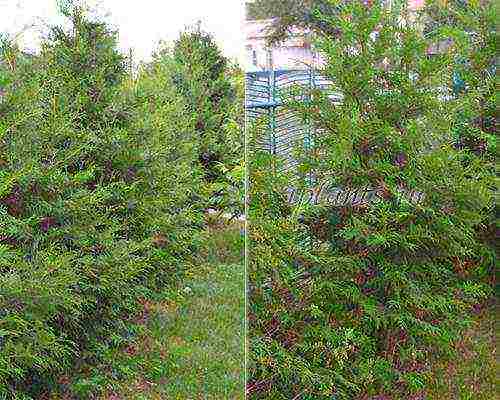
In shady places, the crown forms a loose, sometimes one-sided (if there is severe shading on one side).
In places where there is no sun, it is better to give up growing thuja - they will not only greatly inhibit growth, but also increase the risk of various fungal infections.
If you have a close location of groundwater (1-1.5 m), it is permissible to plant conifers only on an artificial elevation - a bulk hill at least half a meter high.
Planting thuja western
Planting is carried out in prepared pits, on a site freed from perennial weeds - select all rhizomes of nettle, sow thistle and other weeds for digging.
The root system of western thuja depends on the variety - in miniature ones it is much less than in full-grown or semi-dwarfs. For example, in thuja, 3-5 m in height, the roots spread to a depth of about a meter, in two meters - 50-60 cm.
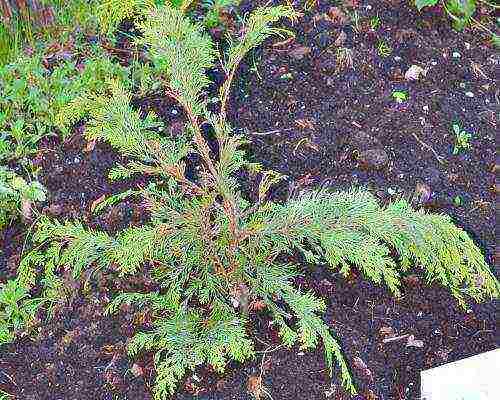
For planting a variety of thuja, which will grow more than 3 m in 10-15 years, you need to prepare a pit measuring a meter by a meter in width and depth, if the soil on your site is not suitable in structure. The planting pit provides a supply of food for the first few years.
Preparing the soil
Thuja prefers soils - medium loam, moderately nutritious, not too moisture-consuming and not dry, slightly acidic.
If the soil is: heavy clayey, light sandy, clean peat - it requires mandatory improvement. Therefore, you need to mix the earth dug from the hole with other components:
- if the soil is clayey, replace half of the excavated soil with equal parts of peat and sand
- if the soil is sandy, replace half of the excavated land with equal parts of peat and loam (sod land)
- if the soil is peaty, replace half of the excavated land with equal parts of loam (sod land) and sand
At the bottom of the pit, we fill in the drainage from crushed stone with a layer of 10-15 cm, then we fill in the mixed soil. To plant the acquired plant in a prepared and filled-in hole, we make a hole 30-40 cm wider and 10-15 cm deeper than the root system of the plant (i.e. we make a hole in the filled-in hole).
Next, mix the removed soil in half with humus (manure that has lain in a heap for 3-4 years) and fill the root system of the plant with this soil.
Acidity and liming
You need to know that nitrogen, potassium and phosphorus, like most of the minor elements (iron, magnesium, sulfur and copper), are the most easily assimilated in soils with a pH of 6.0 to 8.0.
For thuja, the optimum acidity is from 6.8 to 7.2, although they tolerate more acidic and alkaline, which is what the suppliers of planting material use, claiming that thuja grow on any type of soil. This is not so, sooner or later a lag in growth becomes noticeable, the needles turn brown, sometimes the branches or the whole plant dry out.
If the acidity of the soil in your area is below pH 6.5, they should be neutralized to the desired pH with lime or dolomite flour. Read how to do this - soil deoxidation.
How to plant
Water the plant before removing it from the shipping pot. Place the thuja taken out of the container in the center of the hole, spread the roots evenly. Then lift the tree so that the root collar is slightly higher (2-3 cm) than the ground level.
Fill in the prepared soil and carefully compact the soil, pressing down with your hands, just do not squeeze it near the trunk itself. The tree will settle a little with the ground, and the root collar will be flush with the horizon. It cannot be deepened - this will lead to decay.
Now around the tree you need to make a "saucer" for watering - a side made of the ground in a near-stem circle, 5-6 cm high, so that when watering, water does not spread far beyond the root system. If the ephedra is planted on a slope, the "saucer" must be made higher.
It is better to immediately mulch the soil around the thuja with pine bark, chips, for the first time straw is also suitable (not the best option - it lets weeds through and decomposes quickly).
Mulching prevents water from spreading, protects the roots from overheating in hot weather, and retains moisture in the soil for several days longer. Considering that thuja do not tolerate overdrying, mulching is a necessary measure. But at the root collar (10-12 cm in diameter), the minimum layer is to cover the ground by no more than 1 cm, or not cover it at all, so that the trunk does not fall out and does not rot if the weather is too damp.
At what distance to plant thuja
The planting recommendations that you can be given when buying planting material are very contradictory. First of all, you need to decide on the question of whether you are planting in a permanent place or admit the possibility of a transplant.
In general, thuja tolerate transplantation well, especially if the root system is preserved as much as possible, and the time is suitable for such an operation. But sometimes after a few years it will be technically impossible to transplant the trees to a new place. Therefore, plan your garden design ahead of time.
The distance between plants should take into account the final size of the variety and the possibility of crown correction by pruning. For example, in some varieties of columnar thuja, the diameter at the base of the trunk can be almost 2 m, in others - narrow-columnar no more than a meter. Thuja grow slowly, the average growth in height per year is 10-30 cm, in diameter about 5-10 cm. But you need to imagine the garden in perspective, how it will look in 10-15 years, because it will be almost impossible to transplant a full-grown tree.
If you are planning a hedge, say, from the Brabant variety, in which the crown diameter of an adult plant is about 1.5 m, with a planting frequency in a row: every 50-70 cm (such a recommendation occurs) you will have to thin out them after a few years, removing after one. Such large thuja need to be planted at a distance of 80-100 cm.
In addition, you need to take into account whether you want to preserve the natural shape of the planted variety - so that the cone (pyramid) is clearly visible or not - with dense planting, the hedge forms a dense green wall, it is impossible to distinguish individual specimens with the eye.
Another factor is the possibility of curly pruning, there should be enough space around a tree or shrub to freely care for it - strapping, shearing, treatment from diseases and pests.
Thuja western care
Beauty requires an effort - they begin with regular watering, especially the first month after planting - overdrying is unacceptable.
Thuja grows well only on fertile and moist soil. Plants growing in a flowerpot or container do not tolerate overdrying at all. It is more difficult to track the loss of moisture in conifers than in deciduous ones - in those, the leaves hang down like rags, and in conifers they turn yellow and dry. Therefore, watering in the open field should be regular, when there is no rain, approximately once a week.
It is believed that thuja are very well accepted by sprinkling irrigation, water washes away dust from the crown and increases the humidity of the air, but thuja love moist air and grow in nature along the banks and slopes of rivers and reservoirs.
However, during sprinkling, you need to make sure that the water not only drips onto the crown, but also wets the root layer under the trees. If there are signs of a fungal infection on the thuja, try to exclude sprinkling during treatment, carry out regular watering from a watering can.
There are varieties that absolutely do not tolerate both overdrying and low air humidity, for example, Globoza nana (miniature spherical), it is better to plant such varieties near a garden pond, a fountain, a stream.
Improving soil and feeding
After planting, the nutrients of the thuja are enough for several years, as a rule, feeding is not needed for the first two years.
In the future, you can improve the structure of the soil and the fertile soil layer by adding a layer of compost under the trees, 7-10 cm, rake the top layer of earth and replace it with humus, mulch on top with chopped pine bark.
Some varieties, for example, Columna, are sensitive to compaction of the soil surface, the roots do not have enough oxygen, the plants wither, so annual loosening and renewal of mulch is necessary.
If there is no cow or horse humus, you can replace it with leaf humus.

As top dressing, it is desirable to use mainly phosphorus-potassium fertilizers, preferably complex with a set of other minerals, designed specifically for conifers. Usually, two dressings per season, at the beginning and at the end of summer, are sufficient.
Do not forget that the introduction of mineral fertilizers lowers the pH, and exceeded dosages can burn the roots, which manifests itself in the browning of the needles, usually not immediately, but within a month.
Inspection of the crown
Thuja western - an evergreen plant, but the renewal of leaves and twigs occurs regularly, as a rule, "leaf fall" happens in the fall, and since the crown of many varieties is very dense, the process can occur unnoticed for us.
Therefore, do not forget to look inside the crown, push the branches apart and choose yellow needles, sometimes it accumulates between the branches near the trunk, gathering in "tangles".
Pruning
Usually thuja lend themselves well to pruning, do not get sick, and only become thicker after cutting.
If a variety has a columnar shape, this does not mean that the plant will grow branches with a strict pyramidal geometry, some varieties, such as Smaragd, have clear outlines of shape, others, such as Brabant, grow shaggy and need constant pruning to form a well-groomed look.
In young plants, just acquired in the nursery, it is often required to reduce the number of leading branches, otherwise the plant grows into two or three trunks (two-peaked) and all decorativeness is lost. If possible, select in advance specimens of columnar thuja with one leader trunk. If there are several of them, leave one, carefully cut the second. The crown will grow over the season.
Trimming the tips of the shoots should be carried out in the spring, with the opening of the buds and until mid-summer, some varieties, especially fast-growing, spherical or ovoid, need to be pruned twice a season, others, slow-growing less often - once in spring, then the crown overgrows a little over the summer, and plants look more natural. You can shorten the branches by 1/3 of the maximum length, or less if necessary.
Shelter thuja for the winter
Almost all varieties of western thuja need protection from snow and ice. Their branches grow vertically upwards, the snow accumulated and frozen into the ice cap presses on them and breaks them out. Therefore, you need to tie the trunks so that the snow flies off without stopping.

The strapping must be carried out with soft material - nylon tights are just ideal for this role - they do not rot and stretch. You cannot tie the crown too tightly, like Christmas trees before blocking into the body, otherwise the needles inside will rip out.
Small specimens, no more than 1.5 m in height, are best protected not with a harness, but with a hut. Make a tripod from wooden slats and wrap it in burlap or white lutrasil.
It is important to consider the propensity of some varieties to sunburn. There are varieties that are very resistant - the same Smaragd, sometimes the tops of their heads can burn, and there are varieties that require shelter for the most dangerous period - from the end of February to April in the form of burlap or a protective screen.
Sometimes thuja do not burn in the sun for only one reason - they are heavily covered with snow, this applies mainly to young plants and undersized globular, but if the winter is not very snowy, they are threatened with sunburn, so be guided by the weather and precipitation.
Reproduction of thuja western
Thuja can be propagated by seeds and vegetatively: cuttings and layering.
Not all varieties reproduce by seeds, and this is rarely practiced due to the possible loss of varietal qualities, in addition, often non-viable seeds that do not germinate are formed in thuja. Some varietals, like Danica, are propagated exclusively by cuttings. Others, for example, Vareana, Malonyana - give a high preservation of varietal traits during reproduction (80-85%).
The seeds of thuja ripen by the end of October, by November, they cannot be stored, they quickly lose their germination - they immediately send for stratification for 2-3 months in a cold place (+ 2-4C) and sow.
Reproduction of cuttings is quite easy if you cut off the branches for rooting in winter. The optimal time is November, not early autumn, but late, if the autumn is long, you can cut it in December, before frost.
Cuttings root in a warm 22-24C, in a room greenhouse, i.e. at high soil moisture.
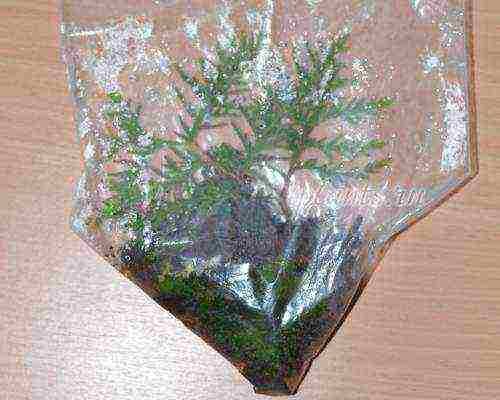
Alternatively, you can use a zip package - i.e. transparent plastic bag with a zip clip - it is convenient to hang it on the window - can be attached to the glass or frame with tape or on a clothespin.
Rooting technique of thuja cutting
We prepare the soil: 1 part of leafy soil (leaf humus) and 1 part of coarse river sand, or vermiculite and sand in equal parts. For one cutting you need about half a glass - a glass of substrate. We mix the components and be sure to sterilize in the microwave or oven. We put it in a bag and pour it a little with boiled water. The soil for germination should not be too moist, only slightly damp.
Cut the stalk about 15 cm long, preferably with a heel, but do not tear it off (the bark is lifted), but cut it off with a sharp knife. From the cutting, you need to remove the lower branches and place it in a bag in the soil.

Close the package tightly and hang it in a bright place - for winter - this is a south window, if the windows are too dark - next to the lamp. It is desirable that the total daylight hours are 12-14 hours.
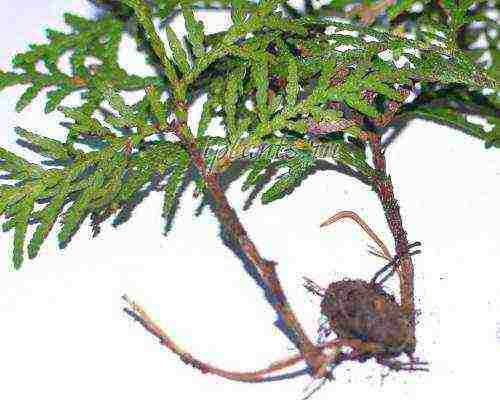
Since the bag is closed, you do not need to water or spray anything. The roots are formed within a month. Do not remove the stalk from the bag, observe: while the needles are green - everything is in order, wait for the root (it is dark) to be visible through the bag, you can take it out and put it in a pot in a substrate consisting of 2-3 parts of leaf humus, 1 part of a large river sand.
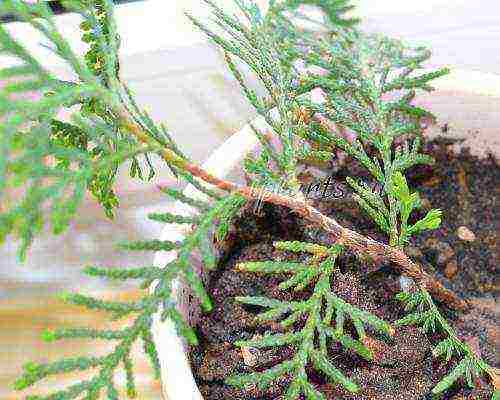
The pot with the planted thuja must be placed in a transparent bag, sprayed with boiled water and tied. After 2-3 days, open the bag for an increasing amount of time - gradually accustom to a lower air humidity.
Similar posts
Ephedra are very popular for decoration, both in the city part and in private estates, decorating the territory throughout the year. Among the variety of coniferous representatives of thuja, planting and care in the open field for which they do not require large labor costs, is the biggest favorite of landscape designers and summer residents.
Common plant varieties
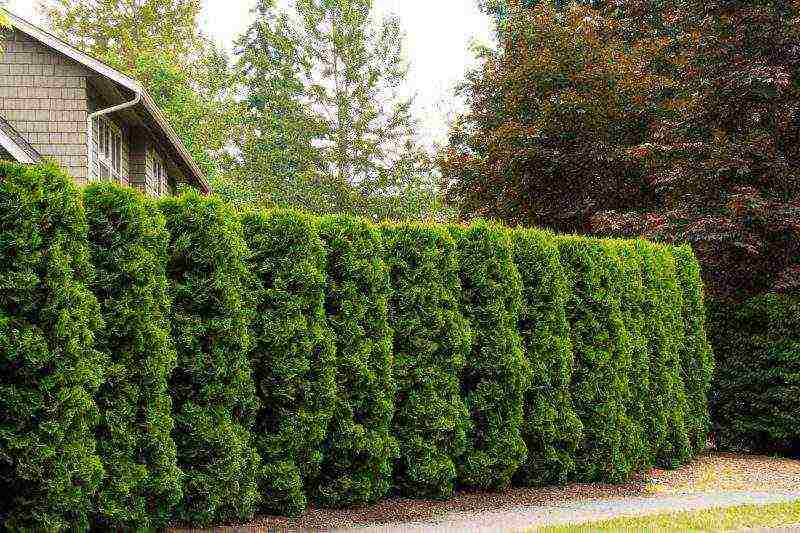
The genus of evergreen shrubs, and sometimes trees, belonging to the Cypress family, includes 5 species:
- thuja western;
- thuja Korean;
- thuja folded;
- Japanese thuja;
- thuja sichuan.
The most common variety that can be found in park areas, near the entrances to administrative buildings and in private territories is thuja western, characterized by slow growth rates, resistance to frost and winds.
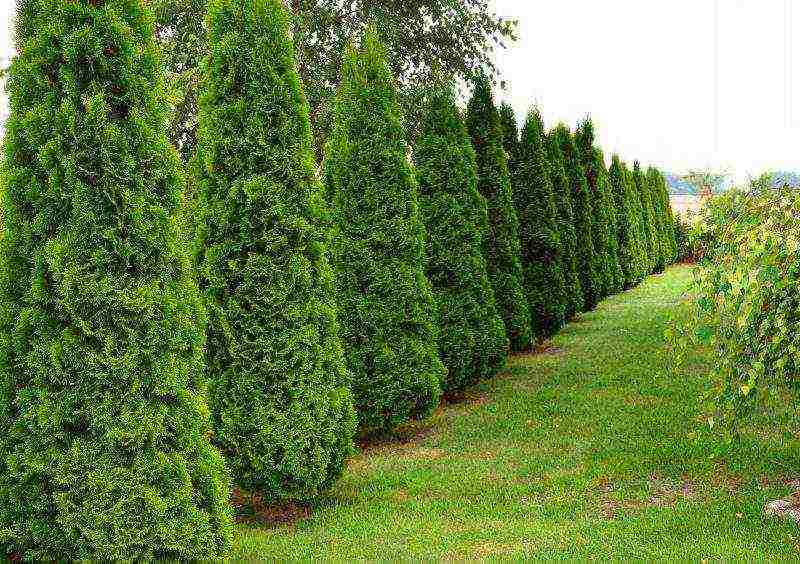
Of the many and varied varieties of evergreen long-liver, the following stand out:
- "Smaragd" is a low-growing cone-shaped bush, not exceeding 2 m, with weak branching. The branches grow vertically, being at a considerable distance from each other.
- "Brabant" is a cone-shaped variety with a significant height of 15-21 m, at which the diameter of the widest section of the crown can reach 4 m.
- "Danica" is a spherical dwarf thuja with a peeling bark of a reddish color.With the onset of winter, the green scales of the needles are set off with a light brownish tone.
- "Woodward" is a low-growing form of a spherical conifer, distinguished by its insignificant maximum dimensions - height - 2.5 m, width - 5 m.
Landing in open ground
Despite the unpretentiousness of the thuja, the evergreen beauty needs a competent approach already at the planting stage, on which the success of the further cultivation of the plant largely depends.
How to choose the right seedlings?
Planting material should be purchased in nurseries or specialized points of sale, focusing on the purpose of the purchase: adult specimens are immediately purchased to decorate the site, and if there is time, then you can opt for young plants, which also take root well. When choosing a seedling, it is examined for the presence of spots, lesions by diseases and pests.
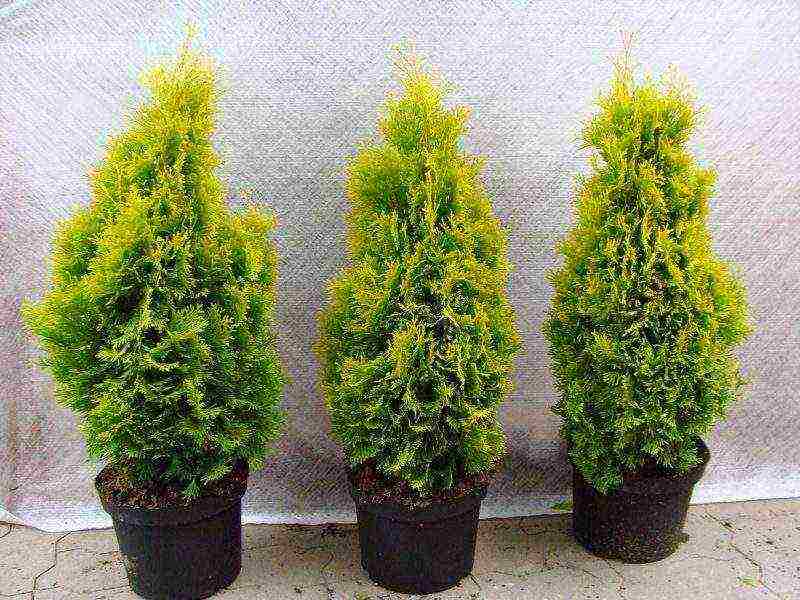
Important! High-quality planting material should have elastic shoots with well-kept needles and a moist rhizome.
Soil preparation and site
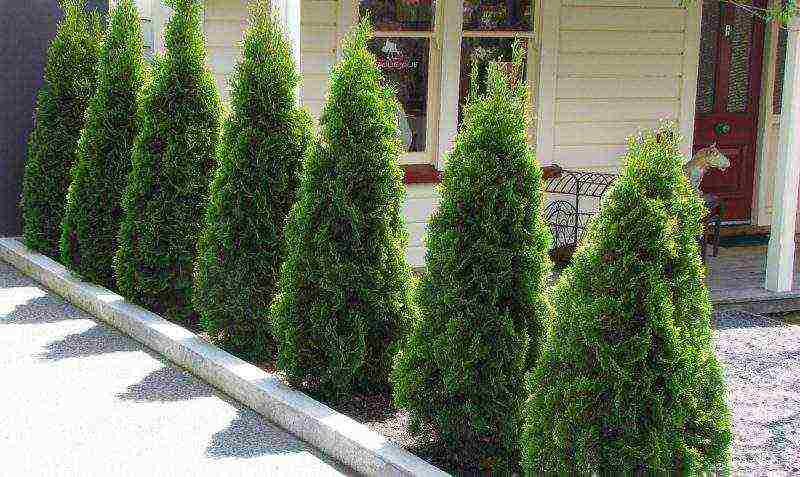
The site for thuja is selected with little shading: direct sun access leads to drying of the shoots, which negatively affects wintering, and an excess of shade harms the decorative qualities of the ephedra, expressed in growth retardation, loss of intense color and splendor. A high level of groundwater is not afraid of thuja, however, in combination with heavy soils, stagnation of water can be observed, which is not permissible when growing a crop. In this case, a drainage layer of 15 cm from crushed brick is placed on the bottom of the hole. The culture is undemanding to the composition of the soil, while preferring a loose and fertile soil, consisting of fertile soil, peat and sand in equal parts.
How and when to plant?

The timing of planting seedlings is extended: the procedure is carried out from spring to autumn. The optimal time is considered the second half of spring, when the planted bushes are able to quickly adapt to the new environment and take root. Planting a thuja in the fall has certain risks due to the uncertainty that the plant will have enough time to take root in the chosen place before the onset of cold weather.
Landing is carried out according to the following scheme:
- Planting holes are dug at a certain distance, depending on the characteristics of the variety and the purpose, of such a size that the plants are freely placed in them along with the soil clod.
- At the bottom of the hole, a drainage layer is organized, which is sprinkled with a small amount of soil with wood ash and organic matter in the form of compost.
- The seedling is lowered into the hole so that the root collar is flush with the earth's surface.
- Thuja is covered with a substrate of earth, sand, peat.
- The soil around the trunk is compacted and watered well.
Advice! With an open rhizome, the ephedra is planted in the spring for successful rooting. Plants from containers with soil mixture are planted throughout the growing season.
Thuja: outdoor care
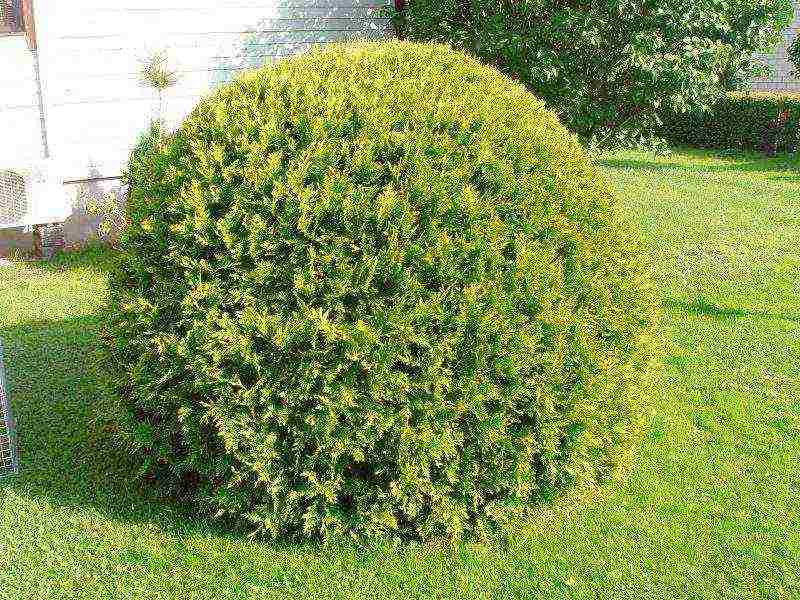
Competent care of thuja provides for the implementation of a set of measures designed for the full growth of the bush.
Watering, loosening and mulching
Ephedra responds excellently to watering, especially sprinkling. Only the planted seedling must be watered every week with a volume of water of 10-50 liters, depending on its size. In the case of sprinkling, not only the earth is moistened, but dust is also removed from the crown, thereby providing the plant with free access to air and accelerating all physiological processes. After irrigation, the soil in the near-trunk circle is loosened to a depth of 10 cm so as not to damage the surface roots. Mulching is carried out using peat, compost or pine bark to protect the roots of the plant from overheating or hypothermia.
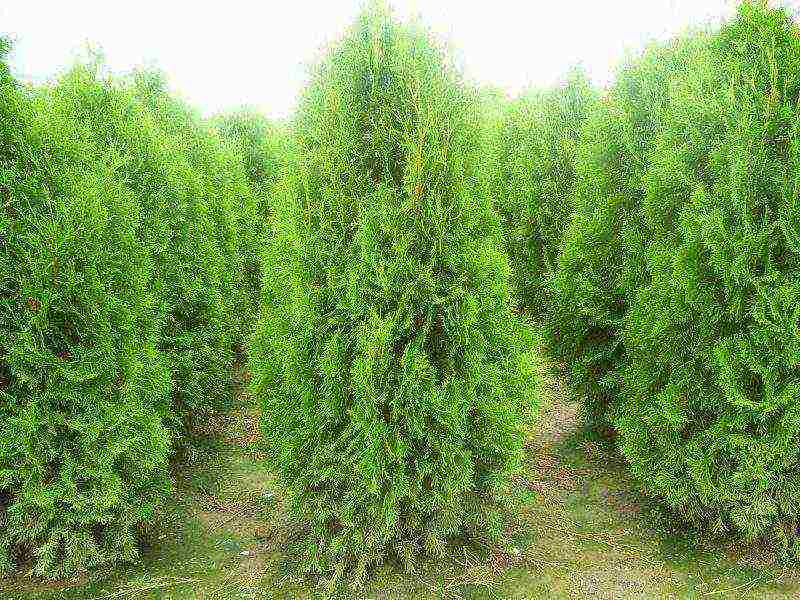
Carefully! The mulch should not cover the trunk or the lower shoots that may begin to rot underneath.
Top dressing
Additional feeding of the ephedra is carried out by the spring application of complex mineral fertilizers with a rate of 50-60 g / m2. If fertilizers were applied during planting, then the first feeding is organized only in the third year of growth.
Crown formation
Pruning stimulates branching of shoots: the more often it is carried out, the greater the density and splendor of the crown. The timing of pruning is not strictly regulated, however, according to experts, it is better to carry out the procedure in early spring before the buds open. Single plantings need a sanitary and thinning haircut.
Formative pruning is required when using thuja as a "green" fence or in group plantings, while:
- The formation of the crown is carried out after the thuja reaches the desired size and age of three years.
- Typically, the plant is pruned twice - in spring and early fall.
- When pruning, it is cut into more than ⅓ part of the shoot, so as not to weaken the plant.
How to transplant correctly?
If it becomes necessary to transfer an ephedra, which easily tolerates a transplant, from one place to another, it is worth considering the age of the bush:
- If the specimen is small, then the soil at a distance of half a meter from the trunk is pierced with a shovel, after which the plant is removed with an earthen clod and transported in a wheelbarrow so as not to destroy the clod.
- Large specimens are stitched a year before moving, so that they have time to grow young roots in a limited area - during this time the soil will bond well, and the procedure will be practically stress-free for the culture.
Preparing for winter
From the middle of autumn, watering and feeding stops, so that the thuja begins to prepare for a state of rest. Young plants, before reaching the age of five, need a shelter of spruce branches, in front of which the plant is huddled, and the near-stem zone is mulched with a thick layer of peat.
Important! Adult specimens do not need to be covered, but mulching, which protects the root from freezing, is required at any age.
Disease and pest control
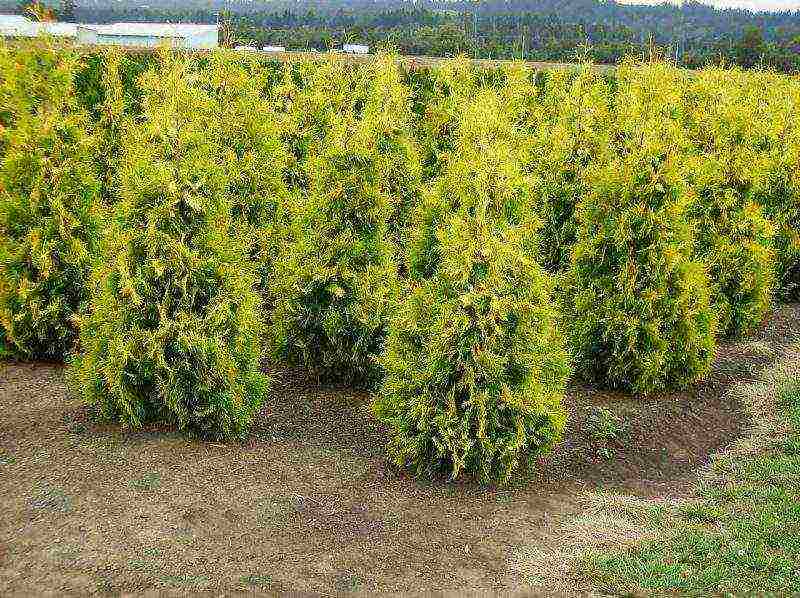
Shoots and needles of a crop are often affected by fungal diseases such as fusarium, shute, cytosporosis. Bordeaux liquid or antifungal fungicides are used as measures to combat the beginning of spring. Three-time treatment is carried out with an interval of half a month. Of the pests on the thuja, false shields and aphids are noted, which often cause yellowing and dumping of needles. For protection, a single treatment with an insecticide is carried out in early spring and after the arrival of summer, double spraying with a two-week time interval.
Reproduction of thuja
Since the varietal characteristics are not preserved with the generative method of reproduction, vegetative methods of breeding thuja are most often used - cuttings and dividing the bush.
Cuttings
To propagate a plant in this way:
- In June, cuttings in the form of lignified three-year shoots 30 cm long or semi-lignified parts of the current season of 15 cm are separated from the mother plant with a heel.
- The separation sites are treated with a rooting stimulant.
- Cuttings are placed in a light and loose substrate, previously disinfected with a solution of potassium permanganate, to a depth of 3 cm.
- Landings are covered with plastic wrap.
- After the formation of roots and hardening of the cuttings, the film is removed, and new plants with a cold snap are covered with dry foliage or sawdust.
Dividing the bush
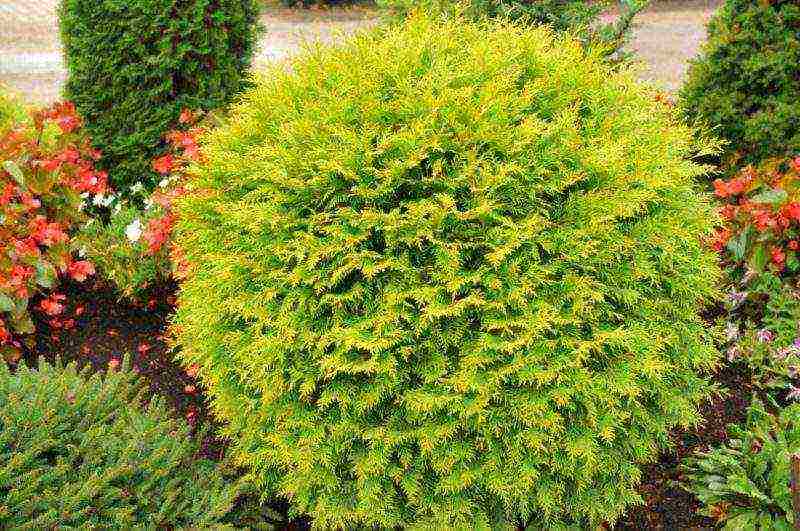
The procedure is advisable to apply to bush undersized forms. For successful reproduction by this method, it is enough to carry out work as during transplantation, but with only a small nuance: the rhizome with an earthen lump is divided into several parts.
Thuja in landscape design

A variety of forms makes it possible for lovers of conifers to implement various ideas for the design of parks, squares and summer cottages:
- Tall varieties are used to form hedges;
- Low-growing representatives are excellent for borders that delimit recreation areas.
- Spherical forms of thuja are often found when decorating alpine slides.
- Group plantings of thuja with needles of different colors contrast perfectly in parks and squares.
- Thuyas are used to decorate patios for air purification.

With minimal maintenance, this elegant evergreen tree will grace your garden for years to come.
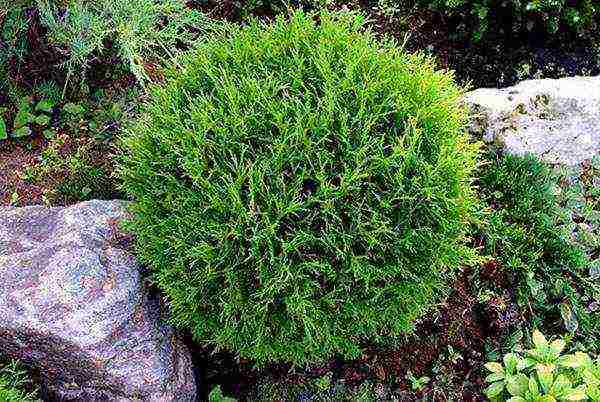 Small compact varieties of thuja are extremely in demand in landscape design. Thuja western Danica - a plant with a dense rounded crown up to 80 cm high and about a meter in diameter belongs to dwarf forms.
Small compact varieties of thuja are extremely in demand in landscape design. Thuja western Danica - a plant with a dense rounded crown up to 80 cm high and about a meter in diameter belongs to dwarf forms.
Such an evergreen shrub will definitely find a place near an alpine hill, in a decorative border, in group plantings among flowering perennials and as a solo plant among stones or ground cover species.
Content
Description of Tui Danica
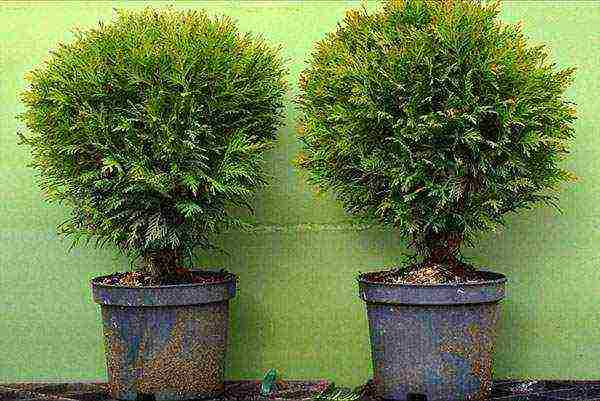 A slow-growing variety, reaching its maximum size not earlier than 15 years of age, was bred in the middle of the last century by Danish botanists. Since then, thuja has become one of the most popular when decorating small areas where it is difficult to find a place for larger crops.
A slow-growing variety, reaching its maximum size not earlier than 15 years of age, was bred in the middle of the last century by Danish botanists. Since then, thuja has become one of the most popular when decorating small areas where it is difficult to find a place for larger crops.
 According to the description, thuja Danica is a coniferous evergreen shrub, the crown of which consists of many shoots densely covered with soft needles. Most of the branches are directed upward, which gives the small plant additional "fluffiness". Young needles covering the ends of the shoots are needle-shaped. Later, it takes the form of scales tightly adhering to the wood. In summer, the crown of thuja western Danica is painted in rich green tones. By the fall, the needles turn brown and remain so until spring.
According to the description, thuja Danica is a coniferous evergreen shrub, the crown of which consists of many shoots densely covered with soft needles. Most of the branches are directed upward, which gives the small plant additional "fluffiness". Young needles covering the ends of the shoots are needle-shaped. Later, it takes the form of scales tightly adhering to the wood. In summer, the crown of thuja western Danica is painted in rich green tones. By the fall, the needles turn brown and remain so until spring.
Plants are durable. With proper care, like other varieties, Danica thuja can reach the age of 150 years.
Of course, today there are no such old copies yet. But at the disposal of lovers of landscape design, thuja Danica Aurea appeared, even more original than the traditional plant.This shrub has not green, but bright golden needles. Withstanding frosts down to –29 ° C, it is just as winter-hardy and at the same time more dependent on sunlight. The unusual shade of the needles fades in the shade, and the crown of both the usual and the golden ephedra gradually loses its spherical shape, becoming loose, sloppy.
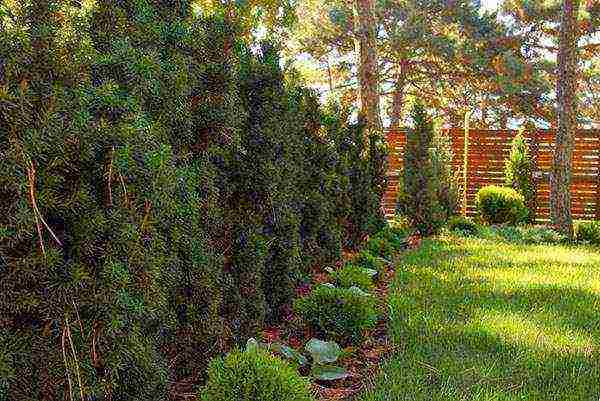 Like all conifers of this genus, this variety of thuja blooms almost imperceptibly. Occasionally emerging brownish-brown cones are rounded and no more than 6 mm in diameter. However, seeds are not suitable for reproduction. In culture, this compact form is only propagated by cuttings.
Like all conifers of this genus, this variety of thuja blooms almost imperceptibly. Occasionally emerging brownish-brown cones are rounded and no more than 6 mm in diameter. However, seeds are not suitable for reproduction. In culture, this compact form is only propagated by cuttings.
Planting and caring for the spherical thuja Danica
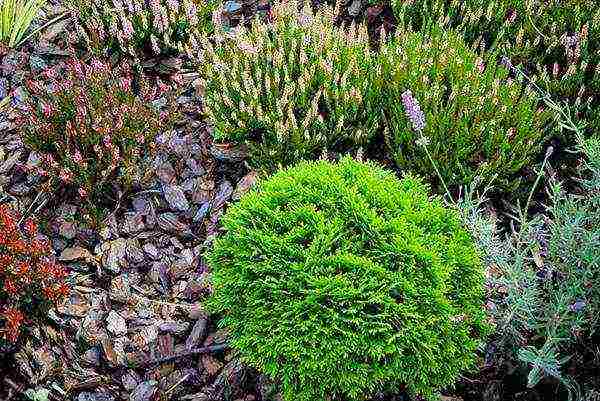 In order for the growing thuja to be lush and bright, it is important for it to find a suitable place. Conifers feel great in the sun and endure partial shade, but, falling under the dense crowns of trees or in the shade of a house, the plants risk losing their decorative effect.
In order for the growing thuja to be lush and bright, it is important for it to find a suitable place. Conifers feel great in the sun and endure partial shade, but, falling under the dense crowns of trees or in the shade of a house, the plants risk losing their decorative effect.
Therefore, an open sunny place with a loose, actively aerated soil is chosen for the spherical thuja Danica shrub. It is important that the root system of the plant does not suffer from close-lying or stagnant waters. Since young specimens are less resistant to cold weather and spring burns, the site must be protected from the wind:
- If thuja is to be planted for the curb, holes for shrubs are dug at a distance of 30 cm from each other. This will allow the crowns of neighboring plants to intersect and form a single, low wall.
- In single plantings, the western thuja Danica is planted at a distance of 50 cm from other plants. Such a measure will help the bush to form a beautiful, even spherical crown.
 Thuja can do without watering for a long time, but grow best on moist fertile soil. A shrub planting hole is made little more than a root system in a container. At the bottom, drainage is made from broken brick, stone chips or expanded clay. The soil for filling the planting pit is mixed with minerals and well-rotted organic matter. After backfilling, the earth is easily tamped and watered, and the circle under the crown is thickly mulched with peat left over after mowing with grass, wood chips or other composition.
Thuja can do without watering for a long time, but grow best on moist fertile soil. A shrub planting hole is made little more than a root system in a container. At the bottom, drainage is made from broken brick, stone chips or expanded clay. The soil for filling the planting pit is mixed with minerals and well-rotted organic matter. After backfilling, the earth is easily tamped and watered, and the circle under the crown is thickly mulched with peat left over after mowing with grass, wood chips or other composition.
After planting, caring for Danika's thuja, as in the photo, consists in watering, adding mulch and monitoring the state of the crown.
In the hot season, the bushes should receive water. To wet the roots, 10–20 liters are poured under each plant. The soil under the thuja is carefully loosened and covered with mulch. In case of prolonged drought and heat, the crown can be irrigated with warm water.
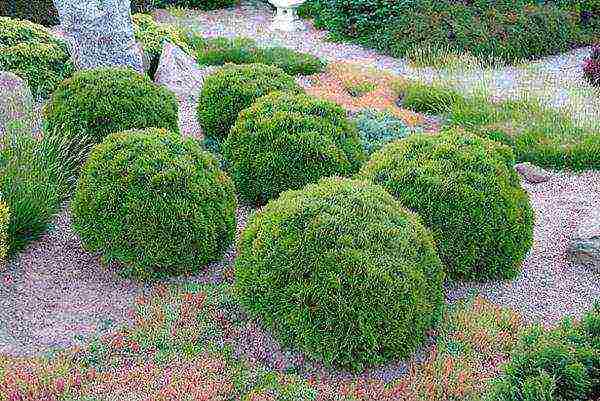 In the spring, conifers are fed with special mixtures that allow the needles to be as bright as possible.
In the spring, conifers are fed with special mixtures that allow the needles to be as bright as possible.
A characteristic feature of the plant is its low growth rate, leaving only 4–5 cm in width and height. Therefore, fertilizers do not have a serious effect on the growth of the crown.
Usually, the thuja Danika, appreciated in landscape design, does not need special formative pruning. However, you cannot do without pruning old, dead or improperly overgrown branches. Sanitary pruning is done in early spring. During her:
- remove dry branches;
- cut branches broken by wind or snow,
- cut off the needles, dried up by the bright spring sun.
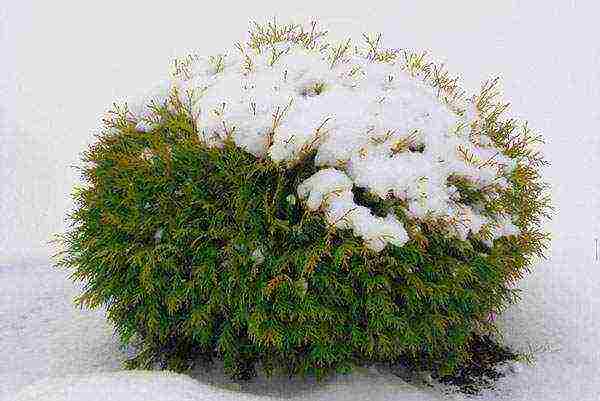 It is better to cover young plants in autumn with spruce branches, which will protect them from frost and ubiquitous rodents, which often take a fancy to the space under the crown for a winter home.
It is better to cover young plants in autumn with spruce branches, which will protect them from frost and ubiquitous rodents, which often take a fancy to the space under the crown for a winter home.
In frosts, thuja bushes are covered with snow. Covering with burlap or non-woven material will help to guarantee a bright crown color for a field of snowless winter.
Tuya Danika in landscape design
 A low-growing thuja with a crown that has a natural spherical shape could not but find its place in landscaping.
A low-growing thuja with a crown that has a natural spherical shape could not but find its place in landscaping.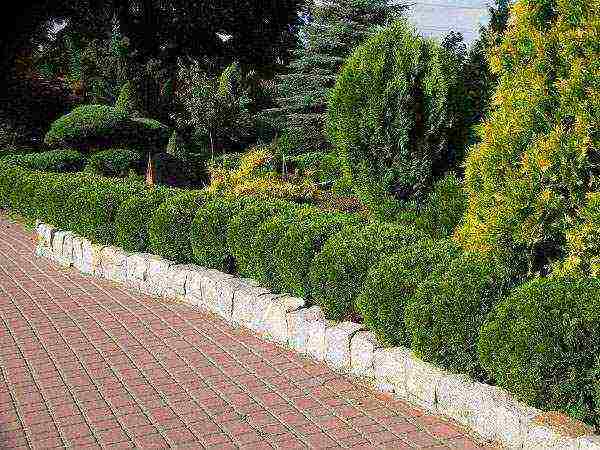
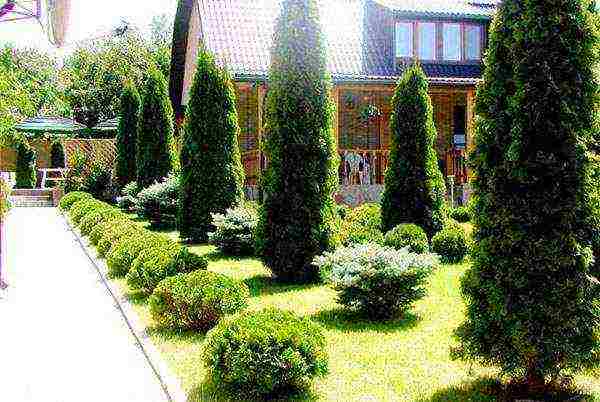 If larger species require a lot of space, complex care and regular haircut, the dwarf plant of thuja western Danica, as in the photo, can be easily imagined:
If larger species require a lot of space, complex care and regular haircut, the dwarf plant of thuja western Danica, as in the photo, can be easily imagined:
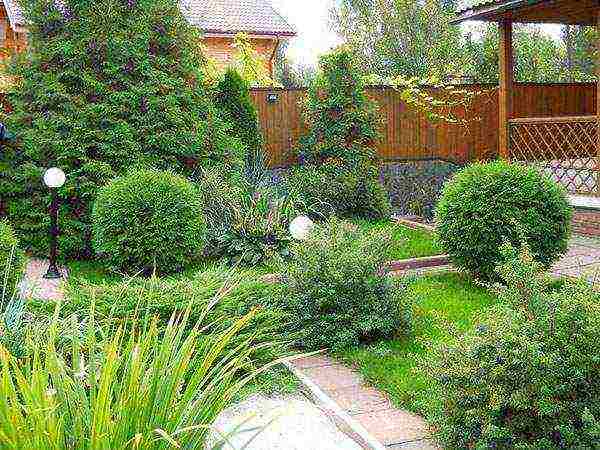 An unpretentious decorative ephedra, even with such a modest size, invariably becomes an adornment of any garden, and its care does not take much time or effort for the gardener.
An unpretentious decorative ephedra, even with such a modest size, invariably becomes an adornment of any garden, and its care does not take much time or effort for the gardener.
 Thuja danica is a plant with excellent decorative properties. Growing this dwarf variety is possible at home, without the involvement of specialists. It is undemanding to the conditions of planting and care, therefore it grows well in the open field in the climate of the middle zone.
Thuja danica is a plant with excellent decorative properties. Growing this dwarf variety is possible at home, without the involvement of specialists. It is undemanding to the conditions of planting and care, therefore it grows well in the open field in the climate of the middle zone.
Description: varieties and varieties of western thuja
Danica is one of the thuja species of the western globular cypress family. Dwarf tree varieties have a neat rounded crown, which looks spectacular in the photo in open ground and in a greenhouse. It is also resistant to frost and city dust. The crown grows 4-5 cm per year, up to about 60-80 cm, and is distinguished by its durability. Other characteristics of thuja Danica:
- the width of an adult plant is up to 1 m;
- dense crown;
- twigs grow vertically;
- needles are thin, scaly, soft, deep green;

Thuja danica is a spherical shrub
- does not bloom, occasionally produces small rounded bumps;
- shoots are short, light green;
- the bark is gray, with a brown or red tint;
- roots lie at the surface.
Attention! The needles of annual seedlings consist of small and thin juvenile needles. And only with growing up are they replaced by a scaly layer.
Among all the variety of western thuja in Russia, the variety Danika Aurea is still in demand. It is undersized, up to 40 cm. Even in the photo it is noticeable that Aurea has lighter and narrower corners. This variety is able to withstand -29 ° C in snowy winters.
Correct planting
In matters of cultivation and care, thuja is unpretentious. Planting outdoors in a sunny area will help form a perfect, healthy crown. Also, the place should be sheltered from the wind. The plant loves light, slightly acidic soils.

Plant the plant away from drafts
Landing is carried out as follows:
- Prepare the substrate in advance. Mix 50% leaf or turf soil, 25% each sand and peat.
- Make a hole 60-80 cm.
- Fertilize the soil with nitroammophos. One seedling - about 500 g.
- Dig in the tree. The root collar should be flush with the soil.
Advice. If the soil in your area is heavy or there is close groundwater, for cultivation, organize a drainage layer of rubble with sand at the bottom of the hole, about 15-20 cm.
Thuja Danica care
Young plant care involves watering once a week. Give the seedling a drink (10–20 liters of water) and water the greens. From the second month after planting, the watering level is reduced. In drought, the amount of water, on the contrary, can be increased.
Advice. Follow each watering with shallow loosening. Also make and update your mulch regularly. It can be collected from dry humus or peat, or from wood chips.
Thuja western normally tolerates frosts, only one-year olds need to be sheltered in open ground. Gardeners use thin burlap. But the plant does not tolerate heat well. In the summer, a shadow for her can be created artificially. Spring care begins with pruning. Remove dry and dead parts, trim the ball shape.
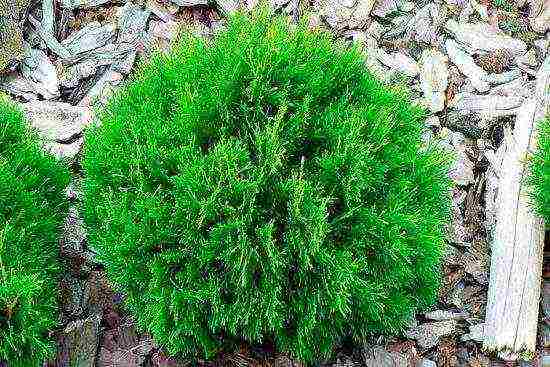
Thuja responds well to feeding
Fertilizer and tree feeding
Ornamental crops can grow without fertilizers. But top dressing will give its crown density and rich color. The technology is simple:
- Organic - during spring and June. Apply fertilizer around the plant under a shallow digging (up to 10 cm).
- Mineral dressing: saltpeter and wood ash. Apply at the same time, alternating with organic.
Advice. Complex mineral mixtures are also used as fertilizers: 50-60 g per 1 sq. m.
Reproduction of a plant at home
If you want to get more specimens of western thuja for decorating plots, work on self-propagation of the plant. The only effective way is grafting. Material is obtained from lignified or semi-lignified shoots. The optimal time for planting and rooting is autumn.
The breeding process goes like this:
- Build a greenhouse.Cuttings root in high humidity conditions. In this case, the walls of the greenhouse should be transparent in order to give the plant abundant lighting.
- Cut off a suitable shoot about 50 cm long. For reproduction, it must have a heel shoot. Remove the needles from the bottom of the cutting and soak in a root stimulant.
- Prepare the soil with equal shares of turf, sand and peat.
- When planting, deepen the cutting by 3 cm.
- Open the greenhouse for 15–20 minutes. in a day. Spray the cuttings.
Attention! If propagation is done correctly, expect roots to appear in about a month. In spring, the seedlings will be ready for open ground.
Diseases and pests of thuja western Danica
The plant is resistant to pests and diseases, but the risk of damage still exists:
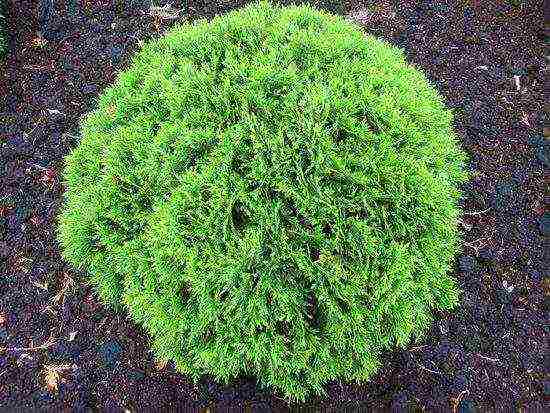
Healthy plant is resistant to pests
- Aphids and spider mites cause yellowing of the needles.
- Due to the needles gnawing insects, the needles become brown, and the tops of the shoots dry out.
- Root pests cause a general deterioration in the condition of the plant and the loss of its decorative qualities.
Attention! There are many chemical preparations for protection against harmful insects. It is important to determine the nature of the disease in order to choose the right treatment.
Diseases of thuja western Danica:
- brown mold;
- trunk rot;
- rotting roots.
The remedy for any rot is radical - burning the affected plant so that the disease does not spread to other inhabitants of the garden. Prevention - spring spraying with fungicide. Brown mold, which manifests itself during spring thaws, is less aggressive. Destroy the dead parts of the tree. Care for healthy elements consists in antimicrobial spraying.
Thuja Danica and its combination with other plants
Growing thuja Danica is possible as an independent decorative element and in combination with other cultures. It looks great in the company of flowering shrubs in the front garden or as a hedge. Dwarf thuja decorate the lawns at the administration buildings. The best neighbor for Danica is the same plant. Although the right combination with other crops, for example, in a rock garden can be attractive. Sometimes, instead of a ball, the owners form bizarre figures from the bush.
All varieties of thuja Danica are decorative conifers that are great for northern latitudes. Proper care will help you get beautiful green balls from delicate needles.
Thuja Danica spherical: video
A dwarf shrub of the correct spherical shape was bred in the middle of the 20th century by a Danish breeder. And it is called - thuja western Danica. The ideal shape of the shrub has become its hallmark. This variety of thuja immediately took the leading position among evergreens in landscape design.
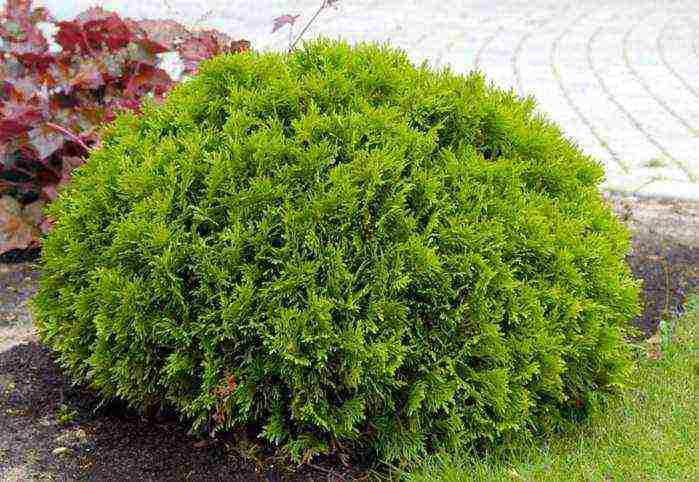 Spherical bush of a thuja variety "Western Danica"
Spherical bush of a thuja variety "Western Danica"
Description of the variety
The time, physical and material costs of caring for this plant do not matter, since thuja Danica looks harmoniously in the design of any site. The spherical shape of the bush has a number of other advantages:
- The crown is dense, its shape does not change as it grows. Short shoots are located close to each other.
- The needles have the correct vertical arrangement, as well as an even distribution along the entire length of the shoot.
- The rich dark green color of the needles does not change all year round. The needles are flat and shiny, composed of scales.
- The miniature size allows this plant to be used both in single and in group plantings.
Danica is a slow-growing variety of thuja. For gardeners, this matters. After all, if you need to plant a composition that is not planned to be changed for many years, thuja Danica is perfect for this purpose. The height of an adult plant is no more than 80 centimeters, the diameter of the green ball is 1 meter. Every year, this variety of thuja adds 5 centimeters in height, while spreading out 4 centimeters in width.So if you planted a young seedling, then in ten years it will be a small bush with a diameter of 40-50 centimeters.
The description of this neat plant can be supplemented with only one fact: flowering is not typical for this variety of thuja, therefore, small brown cones can rarely be seen on it.
How to plant a plant correctly
Planting a thuja begins, as always, with the choice of a place. It can be planted both in a well-lit place and in partial shade. The first option is preferable. If Danica receives a sufficient amount of light, then the crown will be more elegant and magnificent.
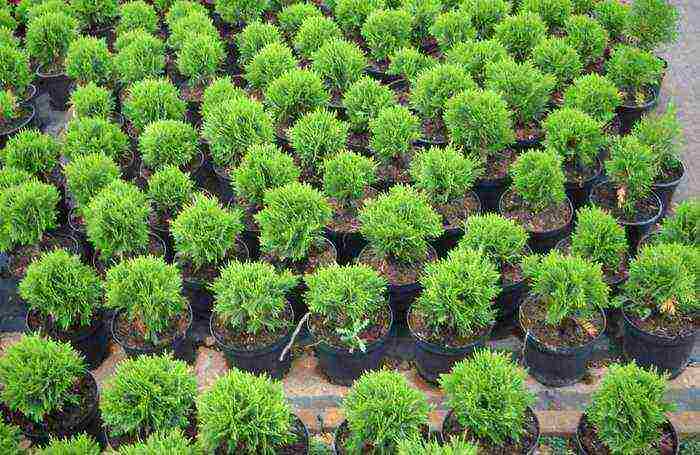 Ready-made seedlings for planting
Ready-made seedlings for planting
This plant is not particularly demanding for the composition of the soil. It is important that the soil is nutritious, not depleted and well hydrated.
You can grow this variety of thuja from seeds, cuttings and ready-made seedlings. Longer care will be required if you are trying to grow thuja from cuttings and, especially, from seeds. Recall that this is a slow growing plant. The best option is ready-made seedlings from the nursery. If they are grown in your area, they are already acclimatized. You do not need to fertilize them additionally. And healthy appearance is the green light to buy.
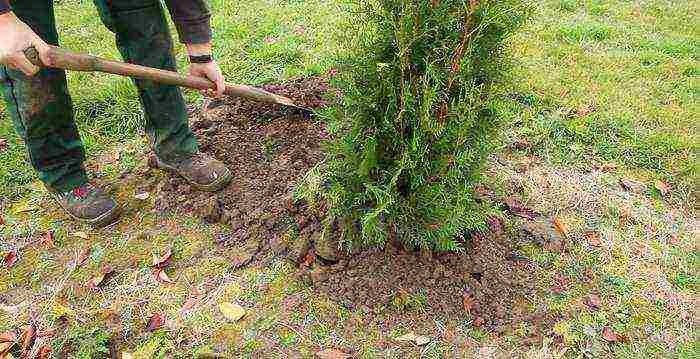 Landing Tui western Danika
Landing Tui western Danika
Plants are planted in the evening or in the morning when the sun's rays are not active. The size of the holes should be slightly larger than the root system. For this variety, all the rules for planting tui are observed, namely:
- good drainage from expanded clay, gravel, broken brick
- a layer of soil from turf, peat and sand
- the location of the root collar at ground level (cannot be buried or exposed) in order to avoid rotting or death of the plant
- mulching with peat, dry leaves or sawdust
- proper care after planting.
Ready-made thuja Danica seedlings can be planted throughout the season from March to November. But it is better to do this in spring or summer, so that the root system has time to get stronger before the onset of cold weather.
Thuja Danica care
Easy care will delight any gardener. Ensure proper watering after planting. If summers are dry, it is especially important to maintain constant soil moisture around the root. Pour at least 15 liters of water under each shrub.
Weeds need to be removed regularly, and the soil around them must be loosened. Loosening should be shallow so as not to damage closely spaced roots.
If you bought ready-made planting material, then you will not need feeding for the first year. Further, in order to increase the density of the needles, to make it brighter and more decorative, you need to regularly apply organic fertilizers around the root zone, slightly digging it up. The best feeding period is from April to June. To improve the quality of the soil, mineral fertilizers are applied - ash or saltpeter.
The Danica variety perfectly tolerates winter cold. But the first few years after planting, it is better to take care of the plant. In severe frosts and a small amount of snow, it will not be superfluous to cover it with spruce branches or burlap.
To protect the beautiful needles from burns in winter, when there are strong temperature drops and the snow melts during the day and turns into ice at night, it is recommended to shake off the snow from the branches. This should be done so that the sun's rays are not refracted in the ice crystals and the needles are not burned. If the ice has already formed, then it should be sprinkled with earth or peat, without damaging the shoots.
It is not necessary to trim this variety of thuja in order to shape it, since it already has a beautiful spherical shape. Sanitary pruning is done in the spring to remove dry and damaged shoots.
Plant care includes a set of measures to combat diseases and pests. Thuja rarely gets sick, but can sometimes be attacked by thuja aphids or false shields. Prevention treatments with insecticides and fungicides will help avoid this problem. If any particular pest nevertheless settled on lush branches, then you will need to purchase drugs to combat this particular insect.
Tuya Danika in landscape design
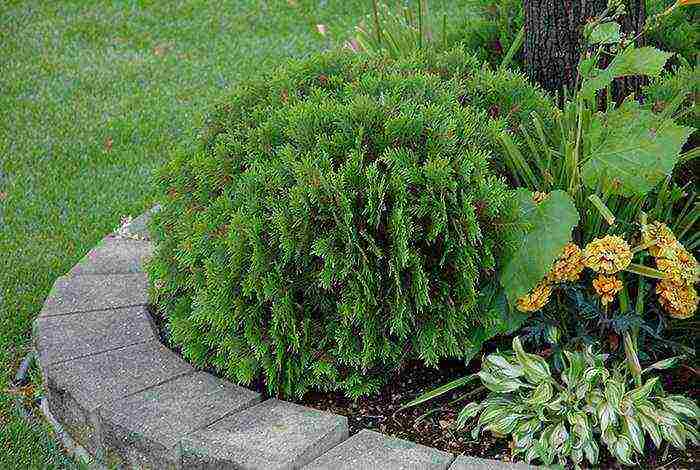 Thuja western Danica in landscape design
Thuja western Danica in landscape design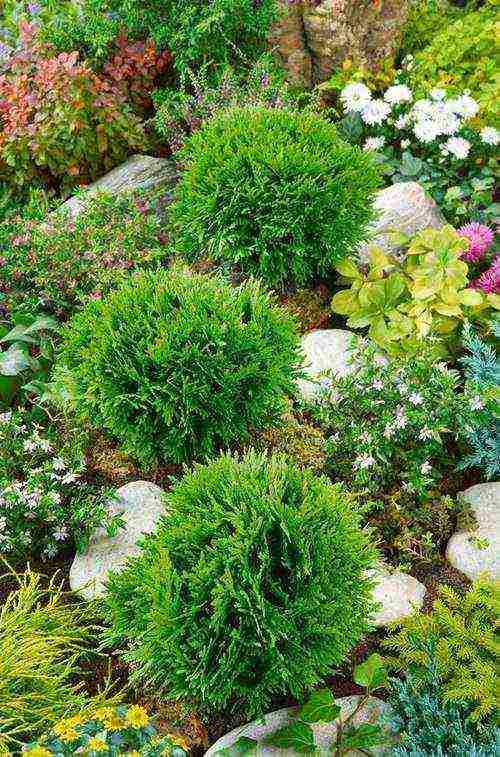 Ideal combination of the variety with other plant species
Ideal combination of the variety with other plant species
The possibilities of using this variety of thuja in landscape design are endless. Use it:
- in single and group plantings, rock gardens
- as a hedge
- for the formation of low-growing curbs to highlight paths in the garden
- in the decor of a rocky garden
- for decorating the entrances to administrative buildings and public institutions
- grown as a tub plant, which can be rearranged at will in different places.
Thuja Danica is not just a luxurious plant. It produces large amounts of phytoncides that kill disease-causing microbes and bacteria. These beneficial volatile substances can enhance human immunity. Therefore, this plant is recommended to be planted in kindergartens and schools.
Video review
Content
Thuja western Danica - planting and care, description, photo of spherical thuja in landscape design, video

Small compact varieties of thuja are extremely in demand in landscape design. Thuja western Danica - a plant with a dense rounded crown up to 80 cm high and about a meter in diameter belongs to dwarf forms.
Such an evergreen shrub will definitely find a place near an alpine hill, in a decorative border, in group plantings among flowering perennials and as a solo plant among stones or ground cover species.
Description of Tui Danica
A slow-growing variety, reaching its maximum size not earlier than 15 years of age, was bred in the middle of the last century by Danish botanists. Since then, thuja has become one of the most popular when decorating small areas where it is difficult to find a place for larger crops.
According to the description, thuja Danica is a coniferous evergreen shrub, the crown of which consists of many shoots densely covered with soft needles. Most of the branches are directed upward, which gives the small plant additional "fluffiness".
Young needles covering the ends of the shoots are needle-shaped. Later, it takes the form of scales tightly adhering to the wood. In summer, the crown of thuja western Danica is painted in rich green tones.
By the fall, the needles turn brown and remain so until spring.
Plants are durable.With proper care, like other varieties, thuja Danica can reach the age of 150 years.
Of course, today there are no such old copies yet. But at the disposal of lovers of landscape design, thuja Danica Aurea appeared, even more original than the traditional plant. This shrub has not green, but bright golden needles.
Withstanding frosts down to –29 ° C, it is just as winter-hardy and at the same time more dependent on sunlight. The unusual shade of the needles fades in the shade, and the crown of both the usual and the golden ephedra gradually loses its spherical shape, becoming loose, sloppy.
Like all conifers of this genus, this variety of thuja blooms almost imperceptibly. Occasionally appearing brownish-brown cones have a rounded shape and a diameter of no more than 6 mm. However, seeds are not suitable for reproduction. In culture, this compact form is only propagated by cuttings.
Planting and caring for the spherical thuja Danica
In order for the growing thuja to be lush and bright, it is important for it to find a suitable place. Conifers feel great in the sun and endure partial shade, but, falling under the dense crowns of trees or in the shade of a house, the plants risk losing their decorative effect.
Therefore, an open sunny place with a loose, actively aerated soil is chosen for the spherical thuja Danika shrub. It is important that the root system of the plant does not suffer from close-lying or stagnant waters. Since young specimens are less resistant to cold weather and spring burns, the site must be protected from the wind:
- If thuja is to be planted for a curb, holes for shrubs are dug at a distance of 30 cm from each other. This will allow the crowns of neighboring plants to intersect and form a single, low wall.
- In single plantings, the western thuja Danica is planted at a distance of 50 cm from other plants. Such a measure will help the bush to form a beautiful, even spherical crown.
Tui can do without watering for a long time, but grow best on moist fertile soil. A bush planting hole is made little more than a root system in a container. At the bottom, drainage is made from broken brick, stone chips or expanded clay.
The soil for filling the planting pit is mixed with minerals and well-rotted organic matter.
After backfilling, the ground is easily tamped and watered, and the circle under the crown is thickly mulched with peat remaining after mowing with grass, wood chips or other composition.
After planting, caring for Danika's thuja, as in the photo, consists in watering, adding mulch and monitoring the state of the crown.
In the hot season, the bushes should receive water. To wet the roots, 10–20 liters are poured under each plant. The soil under the thuja is carefully loosened and covered with mulch. In case of prolonged drought and heat, the crown can be irrigated with warm water.
In the spring, conifers are fed with special mixtures that allow the needles to be as bright as possible.
A characteristic feature of the plant is its low growth rate, leaving only 4–5 cm in width and height. Therefore, fertilizers do not have a serious effect on the growth of the crown.
Usually, the thuja Danika, appreciated in landscape design, does not need special formative pruning. However, you cannot do without pruning old, dead or improperly overgrown branches. Sanitary pruning is done in early spring. During her:
- remove dry branches;
- cut branches broken by wind or snow,
- cut off the needles, dried up by the bright spring sun.
It is better to cover young plants in autumn with spruce branches, which will protect them from frost and the ubiquitous rodents, which often take a fancy to the space under the crown for a winter home.
In frosts, thuja bushes are covered with snow. Covering with burlap or non-woven material will help to guarantee a bright color of the crown of a field of snowless winter.
Tuya Danika in landscape design
A low-growing thuja with a crown that has a natural spherical shape could not but find its place in landscaping.
If larger species require a lot of space, complex care and regular haircut, the dwarf plant of thuja western Danica, as in the photo, can be easily imagined:
- on a rocky hill in the tiniest garden;
- as part of a low, dense curb;
- in a container that is easy to put on a terrace or loggia, use to decorate a spacious hall or patio;
- on a flower garden framed by creeping perennials;
- against the background of tall ornamental-deciduous shrubs or bright tall flowers.
An unpretentious decorative ephedra, even with such a modest size, invariably becomes an adornment of any garden, and its care does not take a lot of time or effort for a gardener.
Thuja western Danica: features of growing and reproduction of an ornamental plant
Thuja danica is a plant with excellent decorative properties. Growing this dwarf variety is possible at home, without the involvement of specialists. It is undemanding to the conditions of planting and care, therefore it grows well in the open field in the climate of the middle zone.
Description: varieties and varieties of western thuja
Danica is one of the thuja species of the western globular cypress family. Dwarf tree varieties have a neat rounded crown, which looks spectacular in the photo in open ground and in a greenhouse. It is also resistant to frost and city dust. The crown grows 4-5 cm per year, up to about 60-80 cm, and is distinguished by its durability. Other characteristics of thuja Danica:
- the width of an adult plant is up to 1 m;
- dense crown;
- twigs grow vertically;
- needles are thin, scaly, soft, deep green;
Thuja danica is a spherical shrub
- does not bloom, occasionally produces small rounded bumps;
- shoots are short, light green;
- the bark is gray, with a brown or red tint;
- the roots lie at the surface.
Attention! The needles of annual seedlings consist of small and thin juvenile needles. And only with growing up are they replaced by a scaly layer.
Among all the variety of western thuja in Russia, the variety Danika Aurea is still in demand. It is undersized, up to 40 cm. Even in the photo it is noticeable that Aurea has lighter and narrower corners. This variety is able to withstand -29 ° C in snowy winters.
Correct planting
In matters of cultivation and care, thuja is unpretentious. Planting outdoors in a sunny area will help form a perfect, healthy crown. Also, the place should be sheltered from the wind. The plant loves light, slightly acidic soils.
Plant the plant away from drafts
Landing is carried out as follows:
- Prepare the substrate in advance. Mix 50% leaf or turf soil, 25% each sand and peat.
- Make a hole 60-80 cm.
- Fertilize the soil with nitroammophos. One seedling - about 500 g.
- Dig in the tree. The root collar should be flush with the soil.
Advice. If the soil in your area is heavy or there is close groundwater, for cultivation, organize a drainage layer of rubble with sand at the bottom of the hole, about 15-20 cm.
Thuja Danica care
Young plant care involves watering once a week. Give the seedling a drink (10–20 liters of water) and water the greens. From the second month after planting, the watering level is reduced. In drought, the amount of water, on the contrary, can be increased.
Advice. Follow each watering with shallow loosening. Also make and update your mulch regularly. It can be collected from dry humus or peat, or from wood chips.
Thuja western normally tolerates frosts, only one-year olds need to be sheltered in open ground. Gardeners use thin burlap. But the plant does not tolerate heat well. In the summer, a shadow for her can be created artificially. Spring care begins with pruning. Remove dry and dead parts, trim the ball shape.
Thuja responds well to feeding
Fertilizer and tree feeding
Ornamental crops can grow without fertilizers.But top dressing will give its crown density and rich color. The technology is simple:
- Organic - during spring and June. Apply fertilizer around the plant under a shallow digging (up to 10 cm).
- Mineral dressing: saltpeter and wood ash. Apply at the same time, alternating with organic.
Advice. Complex mineral mixtures are also used as fertilizers: 50-60 g per 1 sq. m.
Reproduction of a plant at home
If you want to get more specimens of western thuja for decorating plots, work on self-propagation of the plant. The only effective way is grafting. Material is obtained from lignified or semi-lignified shoots. The optimal time for planting and rooting is autumn.
The breeding process goes like this:
- Build a greenhouse. Cuttings root in high humidity conditions. In this case, the walls of the greenhouse should be transparent in order to give the plant abundant lighting.
- Cut off a suitable shoot about 50 cm long. For reproduction, it must have a heel shoot. Remove the needles from the bottom of the cutting and soak in a root stimulator.
- Prepare the soil with equal shares of turf, sand and peat.
- When planting, deepen the cutting by 3 cm.
- Open the greenhouse for 15–20 minutes. in a day. Spray the cuttings.
Attention! If propagation is done correctly, expect roots to appear in about a month. In spring, the seedlings will be ready for open ground.
Diseases and pests of thuja western Danica
The plant is resistant to pests and diseases, but the risk of damage still exists:
Healthy plant is resistant to pests
- Aphids and spider mites cause yellowing of the needles.
- Due to the needles gnawing insects, the needles become brown, and the tops of the shoots dry out.
- Root pests cause a general deterioration in the condition of the plant and the loss of its decorative qualities.
Attention! There are many chemical preparations for protection against harmful insects.
It is important to determine the nature of the disease in order to choose the right treatment.
Diseases of thuja western Danica:
- brown mold;
- trunk rot;
- rotting roots.
The remedy for any rot is radical - burning the affected plant so that the disease does not spread to other inhabitants of the garden. Prevention - spring spraying with fungicide. Brown mold, which manifests itself during spring thaws, is less aggressive. Destroy the dead parts of the tree. Care for healthy elements consists in antimicrobial spraying.
Thuja Danica and its combination with other plants
Growing thuja Danica is possible as an independent decorative element and in combination with other cultures. It looks great in the company of flowering shrubs in the front garden or as a hedge.
Dwarf thuja decorate the lawns at the administration buildings. The best neighbor for Danica is the same plant. Although the right combination with other crops, for example, in a rock garden can be attractive.
Sometimes, instead of a ball, the owners form bizarre figures from the bush.
All varieties of thuja Danica are decorative conifers that are great for northern latitudes. Proper care will help you get beautiful green balls from delicate needles.
Thuja Danica spherical: video
Unpretentious thuja western Danica adorns the landscape all year round
The evergreen coniferous shrub gives the landscape a beautiful look in all seasons. Hatched in Denmark thuja western danica (Thuja occidentalis Danica) - a dwarf spherical shrub of the cypress family, delighted landscape designers with unpretentiousness to light growing conditions and undemanding to soil moisture.
Description of the variety
The name of the variety Danika of a coniferous shrub of the western thuja species reflected country of selection... The variety is characterized by small bushes - up to 80 cm in height and width.Danika has a lifespan of about 200 years, the tree grows very slowly, adding up to 5 cm in height and up to 4 cm in width in a year. The variety belongs to the most miniature spherical thujas.
Thuja branches with small needles are directed upwards. Coniferous needles are soft to the touch. The plant rarely blooms, a small half-centimeter brown cone appears in the place of a faded inflorescence.
Planting and leaving
Danika is planted in full sun and partial shade. Thuja, receiving a sufficient amount of light, has a more lush and elegant crown. The shrub is not picky about the composition of the soil, the nutritional value and moisture of the soil are important for it. Like all western thujas, Danica loves watering, but can withstand the temporary dryness of the soil. It is desirable for the soil pH to be between 5 and 7.
Danica can be grown by cuttings, from seeds, but the plant grows slowly, and growing by these methods requires long-term care. The optimal solution is to grow western thuja Danica with seedlings.
How much are the seedlings
The seedlings are sold in nurseries, they are acclimatized to growing conditions, thanks to proper care they are healthy and have a well-groomed appearance.
The range of prices for seedlings is large - from 850 to 1850 rubles. When forming the price, the plant variety and the height of the bush are taken into account.
Healthy. The cost of seedlings is affected by the territorial prices and the age of the plant.
A pit for planting a seedling is prepared a little larger than a pot with a purchased thuja. So that the roots of the plant do not rot from excess moisture, drainage is laid on the bottom of the prepared place - expanded clay, gravel, broken brick. From above, the drainage is sprinkled with a layer of sand, peat, turf.
A plant taken from a seedling pot, together with an earthen lump, is placed in a hole so that the root collar is at ground level. In order to avoid decay of the root system, the lump of earth with the roots is not buried, and in order to obtain sufficient nutrition for the plant, the roots are not exposed.
The crushed roots need to be straightened, covered with soil with the planted plant, and watered. To retain moisture in the ground and prevent the appearance of a crust, the ground under the thuja is mulched with peat, wood chips, dry foliage.
Healthy. It is necessary to plant plants (planting, transplanting) in the morning or evening, when there is no heat and ruthless ultraviolet rays.
The plant can withstand the dryness of the soil for some time, but it is not worth making it survive. In order for the shrub to be beautiful, it must be watered in a timely manner, occasionally fed with mineral nitrogen-containing fertilizers and calcium.
If aphids, ticks attack the shrub, fungal diseases appear, gardeners resort to insecticides and fungicides.
Shelter for the winter
Thuja Danica tolerates frost well. In areas with snowy winters, seedlings are not insulated. If the winters are snowy and frosty, so that the shrub does not suffer from the cold, it is covered with spruce branches, covered with burlap.
In landscape design
In landscape design, Danica is used in the design of lawns near office buildings, in alpine hills and coniferous-shrub mixborders of the park zone. Tuyu are planted in groups and single plants in the country and in the garden near the cottage.
Danica tolerates a haircut well, and the crown of the thuja is given the shape of animals, geometric shapes. It is rarely necessary to renew a haircut on a slowly growing plant. Dwarf trees are used to decorate a hedge, planting plants close to each other. Varietal plants develop normally in the shade, only needles darken from lack of sun.
Healthy. A plant grown in a sunny place differs from one growing in the shade in a brighter color and density of branches.
They grow a plant in pots to decorate terraces, loggias, balconies.
The miniature tree is suitable for compositions with stone and is used in Japanese-style gardens.
Flowerbed with spherical thuja
On an alpine slide
Composition with stone
Small trees are used in interior design like a bonsai tree.
Spherical western thuja has become widespread in Russia. She keeps the shape of the crown without a haircut, has a beautiful bright green color. Planted around the perimeter of the flower bed, it gives the house plot an aristocratic look.
In a bright composition, thuja greens set off the rich color of other flowers.
Thanks to the green of the spherical thuja, it is easy to create bright accents, and only this shrub is enough to give a well-groomed look to the mixborder in an irregular style.
Danica Aurea variety it has a golden green crown. A spherical tree in 10 years of life grows in height by only 40 cm. Over time, its height will be 1 m. The miniature aurea tree can be grown in homes like a bonsai tree.
Danica Aurea turns yellow in the sun and becomes greener in the shade, intensely colored from mid-summer, the colorful outfit lasts until the onset of cold weather. The golden crown of thuja is harmoniously combined with the green of the grass and the scarlet color of roses.
Danica Aurea's ball looks impressive in a composition with tall green trees and bright flowers.
Thuja look good in compositions with green plants and bright inflorescences. Danica's companions will be:
- conifers, including different varieties of thuja;
- ovoid trees and cone-shaped;
- barberry;
- bladderworm;
- sword-leaved elecampane;
- purple echinacea;
- plants that contrast in color.
The decorativeness of landscape design with thuja will be reduced by climbing plants, braiding a low tree and covering the crown. In a garden composition, a small plant will get lost among closely planted tall shrubs and flowers with a tall voluminous bush. Neighborhood with flowers on a high thin stem and with low, level with thuja stems, landscape designers welcome.
Gardeners' opinions
The reviews of the owners of the plots are full of reports that the frost-resistant decorative Danica came to their taste. She is not afraid of transplants and takes root in a new place, grows well densely planted along the hedge and a single plant. Unpretentiousness to climatic conditions allows you to grow this variety of thuja throughout Russia.
The beautiful appearance of the spherical dwarf thuja motivates the owners of the site to buy several more thujas - of the same variety and other varieties for experimenting with landscape design.
Review on video
The specialists of the Greensad garden center tell about the plant.
Thuja spherical western variety Danika: planting, care and cultivation, design
Thuja western globular "Danica" is a plant of the cypress family and belongs to the dwarf class. This thuja was bred in Denmark, where its name comes from. The plant is very beautiful and unpretentious, so planting it on your site and taking care of it is an excellent choice.
Thuja western Danica Description: The plant looks like a spherical evergreen shrub of regular shape, which has a number of advantages.
- The small size will allow you to create compositions from several bushes, or singly.
- The shape of the crown does not change and requires very little editing with a pruner.
- The needles have a very beautiful color that does not change throughout the year.
- With proper care, thuja Danica will live for about a hundred years.
It should be borne in mind that thuja grows rather slowly, about six centimeters per year (in height), and practically does not bloom.
Selection of seedlings
How to choose seedlings? To do this, you must follow simple rules:
- Purchase planting material in a nursery or from a trusted gardener, this will serve as a guarantee of the survival and purity of the plant.
- It is better to take a plant that has already wintered in the appropriate climate.
- Make sure that branches and roots do not break when transported to the site.
Plant thuja Danica best in the spring, so that the shrub can adapt to the specific climate before the winter cold.
The soil
The best soil for the Western Danica variety is turf, sand and peat. It grows well in clay soil and wetlands. The shrub does not like direct rays of the sun, but partial shade will be optimal for it. It is also necessary to protect the western thuja from strong drafts.
Landing
Planting thuja Danica is not too complicated process. After the landing site has been determined, a hole is dug about ninety centimeters deep and forty centimeters wider than the root ball.
You can add compost or diluted manure before planting. The plant is carefully placed in the hole, spreading the roots. Then the planting hole should be covered with prepared earth and carefully tamped.
The first watering should not exceed the volume of two watering cans. After complete absorption of moisture, it follows with sawdust, chips, etc. mulch the soil to avoid drying out.
Need to traceso that the lower branches and trunk are not mulched.
If several plants are planted, then the distance between them should not be less than one meter, and in the case of planting an entire alley, at least four meters.
Care
Caring for the western thuja Danica will not cause much trouble. Growers say that even without human intervention, the shrub will grow beautifully if the planting site is well chosen. But it is still advisable to observe some points described below.
- The soil under the plant must be loosened at least once a season to a depth of about ten centimeters.
- Dried shoots are removed with a pruner, and a crown of healthy shoots is slightly formed with it. Especially careful pruning should be carried out when the thuja Danica is a living fence.
- You need to feed the shrub no more than once a year, and it is better with organic fertilizer, for example, diluted manure.
- Watering is done in moderation.
- In hot weather and no rain, it will be good to spray the entire plant with water at room temperature.
Pests, diseases
Spherical thuja Danica is quite resistant to various pests. However, troubles can happen with this plant. Description of the main threats:
- Insects that damage the root system can greatly harm the health of the tree.
- Spider mites, aphids, leafworms, etc. are pests for thuja, because of them, it can turn yellow and lose its appearance.
- Insects that damage the needles (pine needles) are also dangerous for thuja. This is, for example, a moth. When attacked by pine needles, the needles will turn brown, and the tops will dry out altogether.
Pest control measures are to spray the shoots with special solutions that can be purchased at a specialized store.
Diseases are rare, but for optimal care it is necessary to be aware of possible problems.
- Rot. When a plant is damaged by a fungus, rot of the trunk and shoots occurs. The needles will turn brown, the texture of the branches is soft, a whitish bloom can be seen on the trunk. The diseased thuja should be removed from the site to avoid contamination of neighboring plants. For prevention, it is necessary to treat the plants with special preparations at least once a year.
- Mold. The disease manifests itself in the spring, manifested by the fact that the trunk is covered as if by a cobweb. Mold develops right under the snow, and it thrives there. When affected by mold, the branches of the tree die. It is necessary to remove the dead branches, remove the cobweb, treat the thigh with an anti-mold agent.
- Rotting root system. A very serious disease characterized by a gray tint of the needles, softening of the trunk, drying out of the branches. The diseased plant should be immediately removed along with the soil around the root ball. The cause of decay is a fungus, the spores of which can remain in the soil.
Reproduction
Reproduction of thuja western Danica spherical is possible both by seeds and cuttings.Growing from seeds is ineffective due to the long growth of the shrub and low survival rate when planting seeds. Therefore, it is preferable to opt for propagation by cuttings. Process description:
- A healthy shoot is taken with the needles removed at the bottom, and placed in a bowl of water for several hours.
- The stalk is planted in a pot with nutritious soil and covered with a greenhouse film.
- Remove the film regularly and spray the cutting.
- When roots appear, remove the film, and then proceed to hardening - regularly take out the dishes with cuttings to the air (when the temperature is above zero).
- In spring, the cutting can be planted in a prepared place.
- Closer to winter, the cuttings must be insulated with covering materials, and the ground around it - with sawdust or spruce branches. Thuja western Danica is ready for the first winter.
Design
Application of thuja Danica in design is very, very wide. It looks good both as a single bush, in groups, and in composition with other shrubs. You can plant a tree in any container and rearrange it as you wish. Thuja is used both as a living green fence and to mark paths on the site. The plant looks great when it decorates the entrance to the building.
Conclusion
Tuya Danica is a versatile plant for a garden, a summer residence, schools and various institutions.
It is beautiful, unpretentious, and also very useful, since its needles release essential substances that cleanse the air from harmful microbes.
Therefore, everyone who wants to decorate their site can recommend this variety for cultivation, because the western The tunic will delight with its beauty for many years, without requiring large expenses from the owners.
Thuja danica
Thuja western Danica: photos, planting and care features
Each owner of a personal plot wants to create a harmonious and cozy atmosphere on their territory.
Today, most conclude that this can be achieved by planting perennial conifers that will decorate the yard and will not require special care. Thuja Danica will be an excellent option in such a situation.
Thuja western globular Danica (Thuja occidentalis Danica) is a plant of the cypress family, attributed to dwarf western thujas.
- Description of the Danica shrub
- Thuja varieties of western Danica
- Shrub planting
- Care and cultivation
- Sunburn protection
- Watering, loosening and mulching the soil
- Fertilization
- Pruning branches
- Protection from winter cold
- Tuya Danika in landscape design
This variety was bred back in 1948 in Denmark, which explains its name. A spherical shrub is quite unpretentious in care, therefore it is often used in landscape design.
Description of the Danica shrub
This variety of thuja will look great on any garden plot, as well as other spherical thuja: Miriam, Golden Globe. But it is Danica who has a number of advantages regarding the financial and physical costs of caring for the plant.
The features of the shrub that make it so popular are as follows:
- the presence of a dense and permanent crown;
- the vertical arrangement of the needles is absolutely correct;
- preservation of rich color by shrubs throughout the year;
- the presence of a compact size.
Thuja western Danica, and scientifically Thuja occidentalis Danica, is an evergreen coniferous tree from the cypress family, growing rather slowly.
The shrub, as indicated above, has a rather compact size: its maximum height can reach 80 cm, and its diameter is 1 m.This size also determines the length of the shoots, which are short dense branches of light green color with a vertical arrangement.
The annual increase in size is 5 cm in height and 4 cm in width, which makes it possible to obtain a crown diameter of 40 cm only after 10 years.
The crown of the Danica shrub represents vertical and parallel rows of dense needles, in a decorative mass creating a kind of ball.
The needles themselves are flat and scaly, with a contrasting dark green color with a shiny sheen. And also fruits in the form of brown round cones with a maximum diameter of 12 mm can be observed.
Thuja varieties of western Danica
Varietal composition of thuja western Danica is represented by only one variety - Danica Aurea. Its small size combined with its gilded color is very popular. As a rule, it is used for planting in rock gardens, group ensembles with diverse conifers, as well as for planting rockeries.
The increase in size is practically similar to the growth rate of thuja Danica. But its maximum height is slightly less - 80 cm. The peculiarity is that in winter the color of this variety acquires a noticeable bronze tint.
Despite the high index of winter hardiness, Danica Aurea requires shelter to protect from the active sun in the spring. In the spring season, it is advisable to carry out preventive measures to protect the shrub with a tank mixture, despite the fact that the distinctive feature of Aurea is its unusually high resistance to diseases and pests.
Shrub planting
Thuja planting begins, like another plant, with the choice of location. So, there is not much difference: whether the choice will fall on a well-lit place or partial shade, but the first option is considered more preferable.
Since the beauty and splendor of the crown will depend on the amount of light received: the more light, the more beautiful Danica will look. This plant has no special requirements for the composition of the soil.
The main thing is that it is not depleted, since it will act as a source of nutrition, and remain hydrated.
Despite the fact that thuja can be grown from seeds and cuttings, planting ready-made seedlings from a nursery is considered the best option. If the nursery is located nearby, then this variety is zoned for the region of future shrub growth. A healthy appearance will indicate the correct choice of a seedling.
Planting of plants should be carried out in the evening or morning, when the activity of the sun's rays is negligible. The holes are not prepared much more than the root system of the seedling. For this variety, all planting rules for thuja must be followed., the description of which is presented below:
- It is necessary to make good drainage from expanded clay, gravel, broken brick.
- There should be a soil layer of turf, peat and sand.
- The root collar should be at ground level, without burials or exposures.
- Mulching should be carried out using peat, dry leaves or sawdust.
- Proper care must be taken after planting.
The timing of planting ready-made thuja Danica seedlings has a huge run-up from March to November. But the optimal ones fall in the spring-summer season. Then the root system will have time to get stronger before the arrival of frosty weather.
Care and cultivation
Caring for a spherical thuja is not difficult, but there are some features that you must definitely know.
Sunburn protection
In the spring before positive night temperatures are established, an ice crust forms on the needles, which can lead to sunburn. Due to the fact that frozen water actually becomes a lens that refracts the sun's rays, it is advisable to shake it off immediately.
Young thuja growing near a white fence in a well-lit place, and even more so on heavy soils, are also susceptible to burns.
As protective measures, the creation of an earthen embankment or sand can act: when the ice melts, the shrub will not suffer.
And also in order to protect against sunburn, you can use burlap, which can be purchased at any building supermarket.It directly covers the shrub, or it stretches over the frame, creating a shadow for the thuja.
Watering, loosening and mulching the soil
Thuya loves moisture and responds positively to additional hydration. In the first two weeks after planting the seedlings, one to five buckets of water must be poured under each, depending on its size.
In summer, when the weather is hot, additional watering should be organized at the rate of one and a half to two buckets per plant. After watering, the soil under the thuja should be loosened to a maximum depth of 10 cm. If you do this deeper, you can harm the root system.
When planting and before the onset of cold weather, it is necessary to mulch using humus, peat, crushed bark, and small chips.
Fertilization
According to experts, there is a reason feed such a thuja with complex mineral fertilizers... Top dressing should be carried out in mid-spring at the rate of 60 grams of solid fertilizers per 1 sq. m. of soil.
And also a good result is provided by the introduction of micronutrient fertilizers. Thuja also responds perfectly to the application of organic fertilizers in the amount of 50 grams per 1 sq. m.
But it should be borne in mind that if fertilizers were applied during planting, then in the next two years there is no need to feed the shrub.
Pruning branches
Shrub pruning is an integral part of a comprehensive care for him. Frequent removal of unnecessary branches makes the greens thicker and more lush. The best time for the procedure is early spring before bud break, but if necessary, it can also be carried out in early autumn.
The first pruning should be carried out no earlier than the age of three years of the bush. As a rule, no more than a third of the branch is removed so that the thuja does not weaken. Before carrying out, you need to prepare a good pruning shears that will not damage the thuja.
Protection from winter cold
If the thuja is already an adult, then there is no need to cover it: it is enough to mulch the soil under the bushes. And if she is not five years old, then she is considered a young plant that requires shelter with spruce branches, protecting it from the cold. But before that, the area around the trunk should be spud and mulched high.
Tuya Danica in landscape design
The potential for use in landscape design of this variety of thuja is endless. For instance, it can be used:
- in single plantings, ensembles and rock gardens;
- as a hedge;
- to create low-growing curbs that highlight garden paths;
- for decorating rockeries;
- for decorating the entrances to administrative and other public buildings;
- as a tub plant in order to be able to change its location if necessary.
Tuya Danica is not only an exquisite shrub, from an aesthetic point of view, but also a means of fighting bacteria and microbes, from a practical one. Since it produces a significant amount of phytoncides that increase the immunity of the human body, it is recommended to plant this plant near children's educational institutions.
So, thuja Danica is one of the most attractive and at the same time simple ornamental plants. Today, many owners of household plots opt for this particular shrub, since it has both a beautiful appearance and a whole list of other advantages described above.
Tuya Danica
Tuya Danica. Description, landing, care:
Planting conifers in the garden or on the plot in front of the house has long been very popular. These wonderful plants with an evergreen crown not only delight the eye in winter and summer, but also fill the air with magical phytoncides that have a beneficial effect on health.
Thuja Danica in the numerous coniferous family is perhaps the most popular plant among gardeners.
Attention is attracted by its beautiful neat appearance, as if a topiary master worked on the tree, as well as miniature sizes, which give the widest possibilities for using thuja in landscape design.
Tuya Danica: description of the plant
The coniferous tree in question belongs to the Cypress family and belongs to the western thuja species. The plant got the name Danica due to the fact that this variety was bred by a Danish breeder. The variety differs in its miniature size and beauty of the crown.
Thuja Danica lives up to 200 years old, grows incredibly slowly, giving an annual growth of about 5 cm in height, and up to 3-4 in volume. Standard 20 cm seedlings, which are most often sold in nurseries, will reach their maximum height of 80 cm after 12 years.
The diameter of their crown will be approximately the same. That is, the plant will look like a living green ball. Danica thuja twigs look up and grow quite compactly. The needles on them are thin, scaly, soft to the touch. In young seedlings, they look like small needles.
Flowers and, as a result, fruits rarely appear in thuja. These are small, slightly more than 0.5 cm in diameter, brown cones.
Seed propagation
Thuja Danica propagates by cuttings and, in the rarest cases, by seeds. The second method is used only if there is no other way to get this plant. Thuja cones are harvested in the fall or early winter, until the seeds spill out of them.
They are dried in a cool place to easily open and get the contents. The seeds must be stratified under the snow. In early spring, they are sown in the ground to a depth of 0.
5 cm and at a distance of 10 cm (or more) from each other, sprinkle with finely chopped needles, mixed with light soil, watered. Seed germination is quite high, but plant growth is unusually slow.
At the age of three, the seedlings will be ready for transplantation in the right place. The disadvantage of this method: the plants grown from seeds almost do not retain the external characteristics of the variety.
Cuttings
Thuja western Danica cuttings reproduce much more often. Planting material is harvested in cloudy weather, cutting off only young one-year-old shoots. Before disembarking, they are kept in water for a day (you can add potassium permanganate). Then they are placed at a slight slope into the ground to a depth of about 6 cm, watered.
You can plant cuttings in a small greenhouse. If this operation is carried out in the spring, rooting will take place in the same year, and if in the summer or autumn, then a callus will form for a whole year, and only the next year will the roots develop from it.
There are cases when thuja grown from lateral shoots did not have an even, beautiful crown, so they try to take cuttings from central branches.
In view of the listed difficulties, it is preferable to buy a danika ready for planting in nurseries.
Where to plant
Thuja Danica is considered a very unpretentious plant. Planting can be done in sunny areas or in partial shade. Any soil is suitable for her, but provided that the pH does not exceed 7 and not lower than 5. In general, all western thujas are calciphiles, and thuja Danica is no exception.
This plant loves watering, but can withstand dry soil for a while. If there is groundwater on the site close to the surface, drainage must be laid at the bottom of the planting pit.
Some gardeners do not fertilize thuja, but these plants still need rare fertilizers with nitrogen and calcium to maintain the beauty of the crown and a healthy existence. On very acidic soils, lime must also be added to the soil.
A pit for a seedling is dug out slightly larger than that of the pot in which it is grown. The plant is placed in it along with an earthen lump, while straightening the crushed roots, carefully covered with earth and watered. Mulch from above.
Care
To any gardener or owner of a private house, only joy will bring thuja Danica.Plant care is simple and easy. After proper planting, it remains only to water the tree until it gets stronger. Then the amount of watering can be reduced.
Thuja can withstand drought, but the tree should not be subjected to such a test. Thuja Danica tolerates frosts no less well. In regions where there is a lot of snow, young seedlings do not need to be insulated, and where the winters are frosty and with little snow, it is advisable to cover the thuja with burlap or spruce branches in the first years after planting.
Taking care of the tree also includes pest control, if they are found. Thuja can be attacked by cypress and thuja aphids, scale insects, false scales, spider mites, thuja moths, and some mushrooms.
You need to fight them with appropriate insecticides and fungicides, and to prevent fungal diseases, treat the tree with Fundozol, according to the instructions attached to the drug.
Use in landscape design
Thuja western Danica is just a treasure for designers. There are countless options for its use. This wonderful plant can be used to decorate curbs, the front entrance to the building, flower beds. Danica is planted on alpine slides, rockeries and green lawns.
It looks great in group compositions and in single plantings, on a small area and in spacious gardens. They also use it as a hedge. The miniature size allows you to grow such a thuja in tubs indoors, decorate loggias and balconies with it.
The dense beautiful crown and the tolerance of the tree for a haircut open up possibilities for a flight of imagination in topiary. Having planted thuja Danica on the lawn or at the entrance to the house, you can make a flower, animal, geometric shapes out of it.
There is a thuja Danica with a golden crown. This variety is called Aurea. In addition to the interesting color of the needles, the variety is distinguished by even slower growth, but in the end the tree can stretch up to a meter in height and up to 1.5 m in width.
